
Find anything, super fast.
- Destinations
- Documentaries
We don't have any additional photos of this yacht. Do you?
Motor Yacht
Atlantide is a custom motor yacht launched in 1930 by Philip & Sons.
Atlantide measures 37.28 metres in length, with a max draft of 2.71 metres and a beam of 5.46 metres. She has a gross tonnage of 137 tonnes.
Atlantide has a steel hull with an aluminium / teak superstructure.
Ken Freivokh Design is a multi-disciplinary team renowned for their uniquely creative design solutions.
Atlantide also features naval architecture by BMT Nigel Gee and Associates and Mylne Yacht Design.

Performance and Capabilities
Atlantide has a top speed of 12 knots. She is powered by a twin screw propulsion system.
Atlantide has a fuel capacity of 28,000 litres, and a water capacity of 5,000 litres.
She also has a range of 3,200 nautical miles.
Accommodation
Atlantide accommodates up to 6 guests . She also houses room for up to 6 crew members.
- Yacht Builder Philip & Sons No profile available
- Interior Designer Ken Freivokh Design No profile available
Yacht Specs
Related news.
- Nautic Shows
- America’s Cup
- Classic Yachts
- Motor Yachts
- Sailing Yachts
- Superyachts
- Yachts News
- Destinations
- Yacht Clubs
- Boat Racing
- Meta Yachts

The team of Royal Huisman and Huisfit is honoured to merit the continued trust of Dr. Jim Clark, who commissioned the shipyard to carry out the very special restoration of his most recent acquisition, the 1930’s yacht Atlantide. This 37m / 122ft classic motorsailer was shipped from Newport, USA, to the Netherlands, and arrived at Royal Huisman’s headquarters in Vollenhove in the first week of 2021.

Jan Timmerman, CEO Royal Huisman comments: “If a discerning client commissions a fourth very substantial project to the same shipyard, you just know that the work you perform is truly appreciated. So we are most honoured to find ourselves in the position to realise yet another dream for our esteemed clients Jim and Kristy Clark. Having received the prestigious “Best Rebuilt Yacht” award for the rebuild-project of the 1913 Herreshoff schooner Vagrant in November 2020, we look forward to starting a new restauration in addition to the current refit projects of Huisfit – a project so grand in scale, that we will be allocating it the same status as a new project. And, a very special, unique, and historic project, which we are certain to make into a success thanks to our skilled craftsmen and women together with the Owners and their team!”
The rebuild of Atlantide is scheduled for delivery in spring 2022.

RELATED ARTICLES
Antigua classic yacht regatta starts this week, les voiles d’antibes, the prestigious gathering for legendary boats, the timeless charm of madiz: one of the oldest yachts in the world, sail through history: exploring the restored presidential yacht of jfk and jackie o, timeless beauties: classic sailing yachts through the ages, restoring winston churchill’s 1936 ‘amazone’ yacht to its former glory.

Subscribe to our newsletter
To be updated with all the latest news, offers and special announcements.
LATEST ARTICLES
Cannes yachting festival 2024: showcasing innovation and joy on the french riviera, sailgp season 4 heats up: bermuda grand prix marks a pivotal turn, exploring ineos britannia’s ac75 launch: a leap in america’s cup competition, emirates team new zealand preparations for america’s cup and kiwi cup raffle, editor picks, canadian beau lake introduces the tahoe ’14 and lugano ’14 electric runabouts, underwater adventure and exploration with deepflight’s super falcon 3s, driving performance on land and on water: 41′ amg carbon edition, popular posts, young designer of the year 2022: ioana valentina corcodel reveals 65m ophelia concept, mirabaud sailing video of the century: celebrating 2 decades of passion, superyacht the flying fox seized in the dominican republic, popular category.
- Regatta 823
- America's Cup 422
- Motor Yachts 264
- Boating 216
- Superyachts 186
- Sailing 179
- Yachts News 174
- Sailing Yachts 165

122' (37.19m) ATLANTIDE Sold
Posted October 15, 2020 in Brokerage & New Build by Morgan Crowe
Northrop & Johnson is delighted to announce the in-house sale of the 122-foot (37.19m) ATLANTIDE by Yacht Broker Hank Halsted, representing the buyer and the seller.
Built in 1930, ATLANTIDE has been the pinnacle of iconic classic yachts at every turn of her 90-year history. Christened as CALETA, she was designed by Alfred Mylne and built by Phillip and Sons of Dartmouth for Sir William Burton, the helmsman of J-Class SHAMROCK, England’s challenger to the America’s Cup in 1930. Burton enjoyed the yacht as a tender to his 12 Meters for a decade until she was recruited to England’s fleet of “Little Ships” for Operation Dynamo, the evacuation of English and Allied troops from Dunkirk. Her service entitled her to be one of the few yachts invited to fly the distinguished St. George’s Cross.
ATLANTIDE was purchased by a Greek shipping magnate after WWII and underwent a two-year total restoration at Thornycroft Shipbuilding, Southampton. She was relaunched as ARIANE in 1948 and graced the Mediterranean’s waters for the next half a century until Yachtsman Tom Perkins purchased her. The motorsailer then underwent a total rebuild and refit at Camper & Nicholson with naval architecture by Nigel Gee & Associates and a new interior, deck and superstructure by Ken Freivokh Design. With $18,000,000 to $20,000,000 spent, this is reputed to have been one of the most expensive refits per meter to date.
Relaunched as new in 1999 and again refit from 2013 to 2015, ATLANTIDE is arguably the world’s most elegantly detailed expedition Motorsailer. Fully stabilized and with a proper sailplan on two spars. ATLANTIDE is a kinetic sculpture, a work of art that comes to life in the utilization. The yacht showcases Art Deco aspects throughout her design and décor to a standard that celebrates the glasswork of renowned Deco artisan Rene Lalique, to an unparalleled level of detail.
ATLANTIDE offers accommodations for six guests in three elegant staterooms, which include a master, VIP and a double bed stateroom. The yacht also has main and dining salons, wheelhouse, and entertaining decks that are sculptures unto themselves.
In a magnificent echo of yachting history, ATLANTIDE has been purchased by International Yachtsman Jim Clark, owner of the J-Class Yacht, HANUMAN. A replica of the 1936 J-Class, ENDEAVOUR II, HANUMAN was built by the Royal Huisman Shipyard in 2009 and has shared the J-Class podium ever since. Having been the tender to the J-Class SHAMROCK after her initial launch in 1930, ATLANTIDE is once again tender to a J-Class Yacht, 90 years later.
For more information, please contact Press@Northrop&Johnson.com . For yachts for sale with Hank Halsted, click here .
Up Next in Brokerage & New Build
Proud to be part of the MarineMax family
© 2024 Northrop & Johnson
- Yachts for sale
- Yachts for charter
- Brokerage News
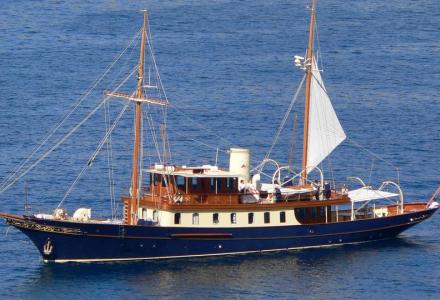
- Yacht Harbour
- Yacht Atlantide
About Atlantide
Contact agent, specifications, similar yachts.
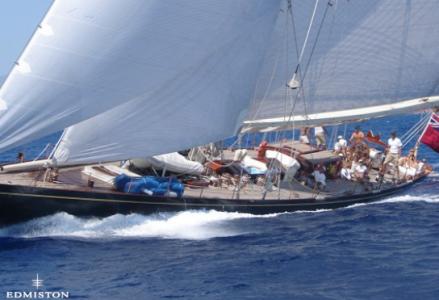
New listings
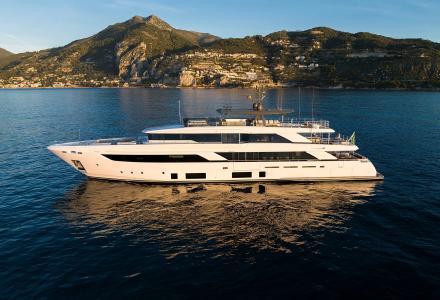
ATLANTIDE Philip & Son
- Inspiration
ATLANTIDE has 4 Photos
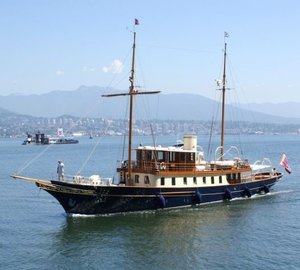
Atlantide News
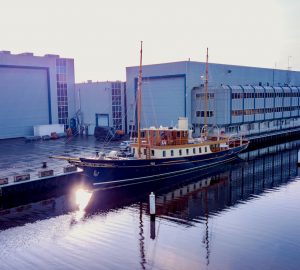
37m Classic luxury yacht Atlantide ...
Similar yachts.
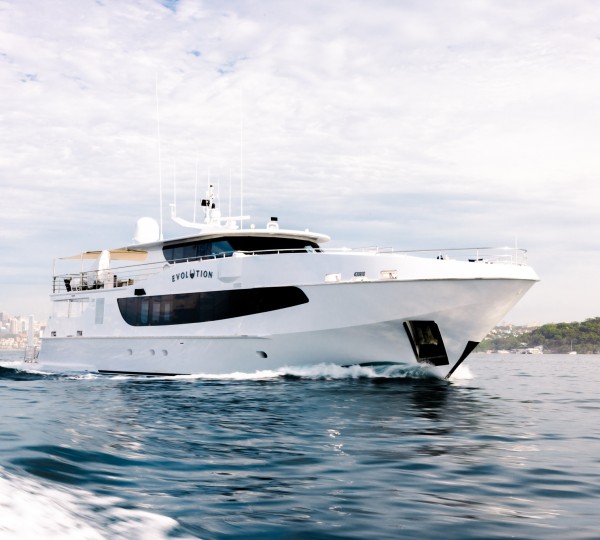
EVOLUTION | From AUS$ 150,000/wk
- Yachts >
- All Yachts >
- All Motor Yachts Over 100ft/30m >
If you have any questions about the ATLANTIDE information page below please contact us .
A Summary of Motor Yacht ATLANTIDE
The well proportioned superyacht ATLANTIDE is a motor yacht. This 37 m (122 ft) luxury yacht was developed at Philip & Son in 1930. ATLANTIDE was formerly called Caleta; Ariane; Corisande. Superyacht ATLANTIDE is a beautiful yacht that is able to accommodate up to 6 people on board and has approximately 6 qualified crew. The graceful superyacht has been brought about from the naval architecture of Alfred Mylne and Bmt Nigel Gee. Ken Freivokh Design / C&c Designs was successful with the interior design and styling.
The Shipyard Work & Naval Architecture with respect to Luxury Yacht ATLANTIDE
The yacht's general design work came from Alfred Mylne and Bmt Nigel Gee. The technical naval architecture drawings are the creation of Alfred Mylne. Motor Yacht ATLANTIDE received her stylish interior designing from the interior design company of Ken Freivokh Design / C&c Designs. Built at Philip & Son the vessel was constructed in the country of the United Kingdom. She was officially launched in Dartmouth in 1930 before being delivered to the owner. The core hull was constructed with steel. The motor yacht superstructure component is fabricated extensively using aluminiumandwood. The measurement of the luxury yacht on deck is 35.2 (115.5 ft). With a beam of 5.46 metres / 17.9 ft ATLANTIDE has reasonable internal space. A shallow draught of 2.71m (8.9ft) determines the list of certain harbours she can enter, taking into account their specific depth at low tide. She had refit maintenance and changes carried out by 2008.
M/Y ATLANTIDE Engineering & Speeds:
This yacht makes use of twin agile GARDNER main engine(s) and can manage a stately maximum speed underway of approximately 12 knots. The main engine of the ATLANTIDE produces 230 horse power (or 169 kilowatts). Her total HP is 460 HP and her total Kilowatts are 338. For propulsion ATLANTIDE has twin screw propellers. ATLANTIDE has a/an supine cruising speed is 10 knots which offers a range of 3500.
Superyacht ATLANTIDE Has The Following Accommodation:
With space for a maximum of 6 welcome guests overnighting, the ATLANTIDE accommodates them in luxury. Normally the vessel has room for circa 6 able qualified crew to manage.
A List of the Specifications of the ATLANTIDE:
Further information on the yacht.
This motor yacht has a teak deck.
ATLANTIDE Disclaimer:
The luxury yacht ATLANTIDE displayed on this page is merely informational and she is not necessarily available for yacht charter or for sale, nor is she represented or marketed in anyway by CharterWorld. This web page and the superyacht information contained herein is not contractual. All yacht specifications and informations are displayed in good faith but CharterWorld does not warrant or assume any legal liability or responsibility for the current accuracy, completeness, validity, or usefulness of any superyacht information and/or images displayed. All boat information is subject to change without prior notice and may not be current.
Quick Enquiry
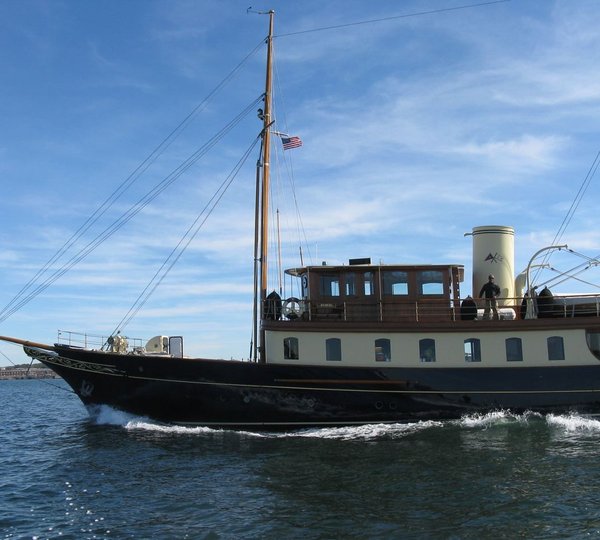
IDYLLE | From EUR€ 65,000/wk
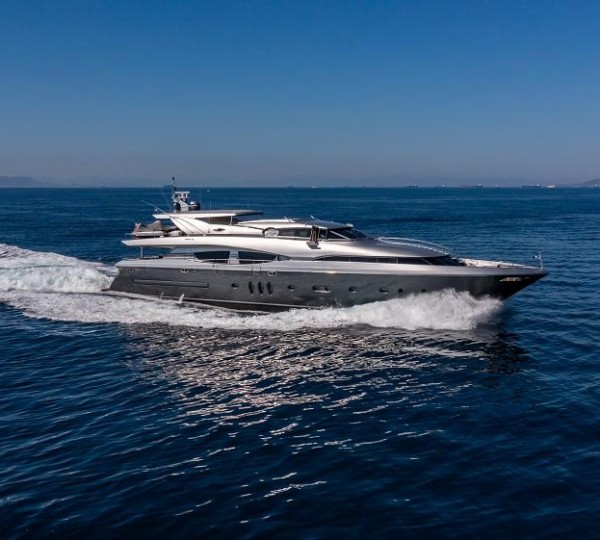
PEFTASTERI | From EUR€ 100,000/wk
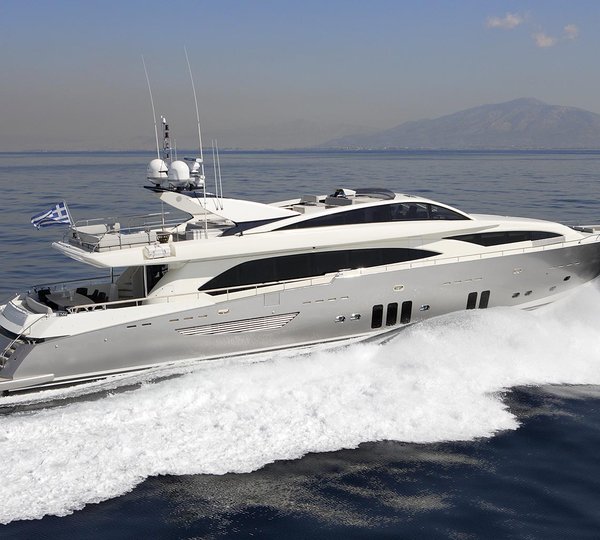
DRAGON | From EUR€ 97,650/wk Special
Please use a modern browser to view this website. Some elements might not work as expected when using Internet Explorer.
- Landing Page
- Luxury Yacht Vacation Types
- Corporate Yacht Charter
- Tailor Made Vacations
- Luxury Exploration Vacations
- View All 3607
- Motor Yachts
- Sailing Yachts
- Classic Yachts
- Catamaran Yachts
- Filter By Destination
- More Filters
- Latest Reviews
- Charter Special Offers
- Destination Guides
- Inspiration & Features
- Mediterranean Charter Yachts
- France Charter Yachts
- Italy Charter Yachts
- Croatia Charter Yachts
- Greece Charter Yachts
- Turkey Charter Yachts
- Bahamas Charter Yachts
- Caribbean Charter Yachts
- Australia Charter Yachts
- Thailand Charter Yachts
- Dubai Charter Yachts
- Destination News
- New To Fleet
- Charter Fleet Updates
- Special Offers
- Industry News
- Yacht Shows
- Corporate Charter
- Finding a Yacht Broker
- Charter Preferences
- Questions & Answers
- Add my yacht
ATLANTIDE Yacht Video
37.28m / 122'4 | philip & sons | 1930 / 2023.
- Amenities & Toys
NOTE to U.S. Customs & Border Protection
SIMILAR LUXURY YACHTS FOR CHARTER
Here are a selection of superyachts which are similar to Atlantide yacht which are believed to be available for charter. To view all similar luxury charter yachts click on the button below.
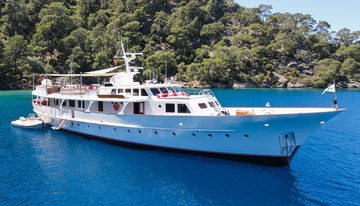
35m | Feadship
from $65,000 p/week ♦︎
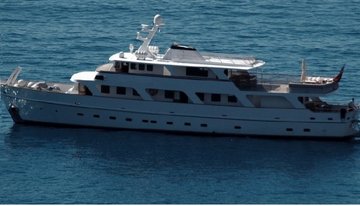
Antares of Britain
34m | Bolson & Son
from $34,000 p/week ♦︎
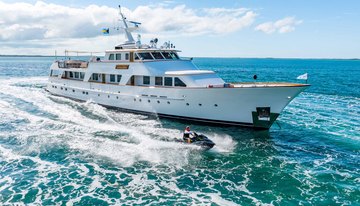
38m | Feadship
from $80,000 p/week

34m | A&P Group
from $70,000 p/week ♦︎
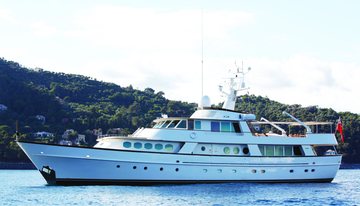
34m | Feadship
from $58,000 p/week ♦︎
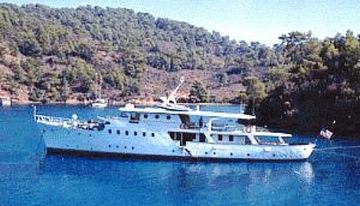
36m | Camper & Nicholsons
POA ♦︎
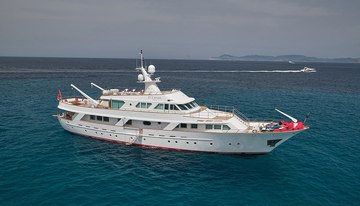
39m | Benetti
from $75,000 p/week ♦︎
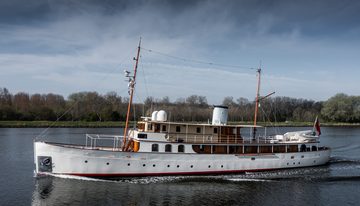
37m | Camper & Nicholsons
from $60,000 p/week ♦︎
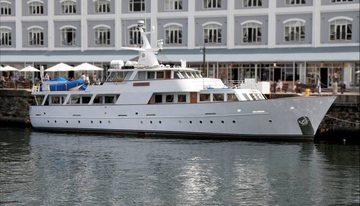
35m | Secni
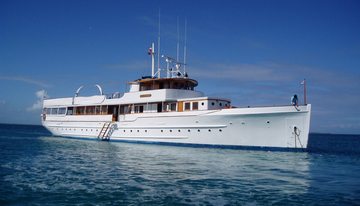
Mariner III
37m | Winslow Marine Rail & Shipbuilding Co.
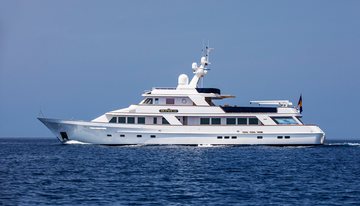
35m | Hugh McLean & Sons
As Featured In
The YachtCharterFleet Difference
YachtCharterFleet makes it easy to find the yacht charter vacation that is right for you. We combine thousands of yacht listings with local destination information, sample itineraries and experiences to deliver the world's most comprehensive yacht charter website.

San Francisco
- Like us on Facebook
- Follow us on Twitter
- Follow us on Instagram
- Find us on LinkedIn
- Add My Yacht
- Affiliates & Partners
Popular Destinations & Events
- St Tropez Yacht Charter
- Monaco Yacht Charter
- St Barts Yacht Charter
- Greece Yacht Charter
- Mykonos Yacht Charter
- Caribbean Yacht Charter
Featured Charter Yachts
- Maltese Falcon Yacht Charter
- Wheels Yacht Charter
- Victorious Yacht Charter
- Andrea Yacht Charter
- Titania Yacht Charter
- Ahpo Yacht Charter
Receive our latest offers, trends and stories direct to your inbox.
Please enter a valid e-mail.
Thanks for subscribing.
Search for Yachts, Destinations, Events, News... everything related to Luxury Yachts for Charter.
Yachts in your shortlist
- Frank Magazine
- Denison History
- Virtual Tours
- Alaskan Yachts
- Azimut Yachts
- Back Cove Yachts
- Beneteau Yachts
- Benetti Superyachts
- Bertram Yachts
- Boston Whaler
- Broward Yachts
- Buddy Davis Sportfish
- Burger Yachts
- Cabo Yachts
- Carver Motoryachts
- Center Console
- Chris-Craft Yachts
- Cruisers Yachts
- DeFever Trawlers
- Dufour Sailboats
- Fairline Yachts
- Feadship Yachts
- Ferretti Yachts
- Formula Yachts
- Fountaine Pajot Cats
- Grady-White
- Grand Banks Trawlers
- Hargrave Yachts
- Hatteras Yachts
- Hinckley Picnic Boats
- Horizon Yachts
- Hydra-Sports
- Intrepid Boats
- Jarrett Bay Sportfish
- Jeanneau Yachts
- Kadey-Krogen Trawlers
- Lazzara Yachts
- Luhrs Sportfish
- Marlow Yachts
- Maritimo Yachts
- Marquis Yachts
- McKinna Motoryachts
- Meridian Yachts
- Midnight Express
- Mochi Craft
- Neptunus Motoryachts
- Nordhavn Trawlers
- Nordic Tugs
- Ocean Alexander Yachts
- Offshore Yachts
- Oyster Sailing Yachts
- Pacific Mariner Yachts
- Palmer Johnson Yachts
- Pershing Yachts
- Prestige Yachts
- Princess Yachts
- Pursuit Yachts
- Riva Yachts
- Riviera Yachts
- Sabre Downeast
- San Lorenzo Yachts
- Sea Ray Boats
- SeaVee Central Consoles
- Selene Trawlers
- Scout Yachts
- Sunseeker Yachts
- Tiara Yachts
- Trinity Superyachts
- Viking Yachts
- Westport Yachts
YACHTS FOR SALE
Browse through a large selection of any brand of yacht for sale. Use the search field below to find your yacht.
- Aage Nielsen 1
- Abd Aluminum 1
- Abeking & Rasmussen 7
- Absolute 85
- Ada Yacht 3
- ADA YACHT WORKS 2
- Adrenaline 3
- AEGEAN YACHT 9
- African Cats 1
- Al Rubban Marine 2
- Al Shaali 1
- Albemarle 12
- Alfamarine 6
- Alfastreet 7
- Alfastreet Marine 3
- All Ocean 11
- Altamarea 1
- Aluminum Boats Inc 1
- American Tug 9
- ANASTASSIADES & TSORTANIDES 1
- ANTON DU TOIT 1
- Apollonian 2
- Apreamare 19
- AQUA BAY BOAT WORKS 1
- Aqua Cruiser 1
- Archipelago 1
- Arno Leopard 15
- ARREDOMAR 1
- Astilleros 1
- Astilleros Celaya 1
- Astilleros De Mallorca 1
- Astondoa 47
- Atlantic Marine 1
- Atlantis 11
- Austin Parker 6
- B & D BOATWORKS 1
- Back Cove 47
- Baglietto 10
- BAHAMA BOAT WORKS 2
- Barcos Deportivos 1
- Barker Boatworks 6
- Barquentine 1
- Barracuda 1
- Bayliner 21
- Beneteau 433
- Beneteau America 35
- Benetti Sail Division 6
- Bennington 4
- Bering Marine 4
- Black Pepper 1
- Black Thunder 2
- Black Watch 1
- Blackfin 32
- Blackwater 8
- Blackwell 4
- Blackwood 2
- Bladerunner 1
- Blu Martin 1
- Blubay Argo Boats 2
- Blue Jacket 1
- Blue Wave 1
- Bluegame 16
- Bluewater 11
- Bluewater Sportfishing 2
- BODRUM OGUZ MARIN 2
- Bord a Bord 1
- Boston Boatworks 1
- Boston Whaler 349
- Bracewell 2
- Bray Yacht Design 1
- Breaux Bay Craft 1
- Breaux Brothers 4
- Bristol Channel Cutter 1
- Brix Marine 1
- Broadblue 1
- BRODOSPLIT CROATIA 1
- Brooke Marine 2
- Brooklin Boat Yard 2
- Bruce Roberts 5
- Bruno & Stillman 1
- BRUNO ABBATE 3
- Buddy Cannady 1
- Buddy Davis 24
- BUNKER & ELLIS CRUISER 1
- C & L 1
- C.W. Hood 2
- Cabo Rico 5
- Cabriolet Royale 1
- Calafuria 2
- Californian 11
- Camper & Nicholsons 5
- Canoe Cove 2
- Cantiere Delle Marche 4
- Cantiere Navale Arno 1
- Cantiere Navale Di Pesaro 1
- Cantiere Navale Rondolini G & Figli 1
- CANTIERE NAVALI DI PESARO 1
- Cantieri Di Pisa 9
- Cantieri Di Sarnico 6
- Cantieri Estensi 4
- Cantieri Navali Del Mediterraneo 3
- CANTIERI NAVALI DI TERMOLI 1
- CANTIERI RIVA SPA 2
- Canyon Bay 3
- Cape Fear 1
- Cape George 4
- Cape Horn 8
- Cape Island Cruisers 1
- CAPE POWER CAT 1
- Cape Powercat 2
- Capoforte 2
- Carnevali 2
- Carolina Classic 10
- Carroll Marine 1
- Castagnola 3
- CASTOLDI JET TENDER 1
- Catalina 30
- Catamaran 4
- Catamaran Cruisers 1
- CAVUSOGLU 1
- CD HOLMES 1
- Cdk Technologies 3
- Center Console 2
- Centurion 1
- Cerri Cantieri Navali 9
- CG Boat Works 1
- Ch Marine 3
- Chantier De L'esterel 1
- CHANTIERS YACHTING 1
- Chaparral 20
- Cheoy Lee 26
- Cherubini 5
- Chesapeake 3
- Chris-craft 118
- Christensen 6
- Cigarette 58
- Cigarette Racing - Don Aronow 1
- Cim Shipyard 1
- Claasen Jachtbouw 1
- Classic Coaster 1
- Classic Craft 1
- CLASSIC YACHT 1
- Classic-Yachten 1
- Cnm - Cantieri Navali Del Mediterraneo 2
- Cnt Castagnola 2
- Coastal Craft 7
- Cobra Ribs 2
- Colin Archer 4
- COLVIC CRAFTS 1
- Commercial 4
- Composite Yacht 2
- Concordia 3
- Conrad N.v. Kalp Holland 1
- Conrad Shipyard 1
- Contender 59
- Cooper Marine 7
- Cooper Queenship 1
- CORSAIR MARINE 1
- Covey Island 2
- Crownline 29
- Cruise Ship 3
- Cruisers 144
- Cruisers Sport Series 2
- Custom Built 25
- Custom Carolina 36
- CUSTOM CAROLINA BOBBY SULLIVAN 1
- Custom Line 35
- Custom Made 1
- Custom Motor Yacht 2
- CUSTOM STEEL MOTORYACHT 1
- Custom Work Barge 1
- Custom Yacht 1
- Cutwater 27
- D'este 1
- Dalla Pieta 10
- Damen Yachting 1
- De Antonio 31
- De Cesari 2
- De Haas Shipyard 1
- DE RUITER 1
- De Vries Lentsch 4
- DE VRIES LENTSCH (DUTCH BUILT) 1
- Deep Impact 8
- Dellapasqua 3
- Delta Marine 6
- Delta Powerboats 15
- Destination 2
- Devonport 1
- Diesel Duck 1
- Dix Harvey 1
- Doggersbank 2
- Dominator 14
- Don Smith 2
- DONZI MARINE 3
- Dovercraft 1
- Dreamline 3
- DRETTMANN 1
- Dubbel & Jesse 1
- Duckworth 1
- Dudley Dix 1
- Dufour Catamarans 1
- Dutch Barge 1
- DutchCraft 1
- Dynamique 1
- EAST ASIA COMPOSITES 1
- Edgewater 31
- Egg Harbor 8
- Elan Power 4
- ELEGAN GROUP 1
- Emirates Boats 1
- Endeavour 2
- Endeavour Catamaran 3
- ENGELAER SHIPYARD 1
- Enterprise Marine 2
- EUROCRAFT 1
- Euromarine 1
- Everglades 66
- Evolution 3
- EXCESS CATAMARANS 2
- Expedition 1
- Explorer Motor 1
- Explosion Marine 2
- Extreme Boats 7
- F&S BOATWORKS 1
- FABIO BUZZI 1
- Factoria Naval De Marin 1
- Fairline 165
- FARR YACHT DESIGN 1
- Fb Design 2
- Feadship 27
- Ferretti 184
- Ferretti Custom Line 6
- FERRONAVALE 1
- FIART MARE 2
- Filippetti 1
- Filippetti Yacht 1
- FITTIPALDI 1
- FLAGSHIP SUPER 1
- Floe Craft 1
- Florida Bay 1
- Forbes Cooper 1
- Formula 156
- FORZA YACHT 1
- Fountain 104
- Fountaine Pajot 123
- Four Winns 27
- Franchini 6
- Fratelli Aprea 2
- FRATELLI ROSSI-CLEMMA 1
- Frauscher 12
- Fred Shepherd 1
- Front Runner 18
- G-WIND MARINE 1
- Gagliotta 2
- Gamefisherman 10
- Garlington 5
- GDANSK / FILIPIAK 1
- GEMINI CATAMARANS 1
- GEORGE S LAWLEY & SONS 1
- Glacier Bay 2
- GlassTech 1
- Glasstream 7
- Global Boatworks 1
- Gold Coast 1
- Grady-white 175
- Grand Alaskan 3
- Grand Banks 82
- Grand Craft 3
- Grand Harbour 2
- Grand Soleil 7
- Grandezza 2
- Granocean 4
- Great Harbour 2
- Green Marine 1
- Greenline 19
- Gulf Craft 13
- Gulf Craft Inc 3
- Gulf Crosser 1
- Gulf Stream 1
- Gunderson Marine 1
- Guy Couach 7
- H&h Marine 1
- Hacker-craft 3
- HAKES MARINE 1
- HALL RUSSELL 2
- Hallberg-rassy 23
- Halvorsen 1
- Hans Christian 6
- Harbor Guard 1
- Harbor Master 3
- Hargrave 31
- Harris FloteBote 2
- Hatteras 229
- Hayaari Marine 1
- Hell's Bay 1
- Henriques 3
- Heritage East 1
- Herreshoff 2
- Hinckley 90
- Hinckley Sport Boats 4
- Hines-farley 4
- Holland Jachtbouw 4
- Houseboat 2
- Husumer Schiffswerft 1
- Hydra-sports 32
- Hydrolift 4
- Innovazione E Progetti 2
- Integrity 3
- Intermare 3
- Intermarine 1
- International 1
- Intrepid 130
- INTREPID POWERBOATS INC. 20
- Introductory 1
- Invictus 18
- Invincible 76
- Island Hopper 1
- Island Packet 27
- Island Pilot 3
- Island Spirit 4
- Italboats 1
- Italcraft 3
- Italyachts 2
- Jarrett Bay 8
- Jarvis Newman 4
- Jeanneau 351
- Jefferson 7
- Jersey Cape 1
- Jespersen 1
- Jim Smith 4
- JOHN WILLIAMS BOAT COMPANY 1
- Joker Boat 3
- JONES GOODELL 1
- Jones-Goodell 1
- Joubert-Nivelt 2
- Judel and Vrolijk 1
- KADEY KROGEN 2
- Kadey-krogen 4
- KEITH MARINE 1
- Kelly Peterson 1
- Kha Shing 3
- King Marine 1
- Kingfisher Cruisers 1
- Km Yachtbuilders 1
- Knight & Carver 5
- Knight Brothers 1
- Kong & Halvorsen 3
- Kuipers Woudsend 1
- KUIPERS WOUDSEND BV 1
- Ladenstein 6
- Laminated MY 100' 1
- Latitude 46 2
- Laurent Giles 1
- Lazy Days 2
- LAZY DAYS MANUFACTURING CO 1
- Le Breton 1
- Leopard 108
- Lifestyle 1
- Liquid Metal Marine 1
- Little Harbor 14
- Little Hoquiam 1
- Long Island 8
- Longline Fishing Vessel 1
- Lord Nelson 1
- LOUISBOURG 1
- Luxe Clipper 1
- LYMAN MORSE BOAT CO. 2
- Lyman-morse 4
- Magna Marine 2
- Magnum Marine 3
- Maine Cat 1
- Mainship 23
- Malcolm Tennant 1
- Mangusta 50
- Mano Marine 1
- Marc Lombard 1
- Marcelo Penna 1
- MARINE MAGIC 1
- Marine Trader 6
- Maritimo 21
- Marlineer 1
- MARLOW HUNTER 1
- Marlow-hunter 2
- Marsaudon Composites 1
- Mast & Mallet 1
- Mastercraft 29
- Mastro D'Ascia 1
- MATHEW BROTHERS 1
- Mathews Brothers 4
- Maxi Dolphin 4
- Mays Craft 2
- MC CONAGHY 3
- MC MILLAN 1
- Mcconaghy 13
- Mediterranean 1
- Mengi Yay 8
- Menorquin 10
- Meridian 65
- Metal Shark 1
- Metalships 1
- Midnight Express 38
- MIDNIGHT EXPRESS POWERBOATS 4
- Midnight Lace 1
- Midship Marine 2
- Miller Marine 1
- MINNEFORD YACHT YARD 1
- Miss Tor Yacht 1
- Mochi Craft 7
- MONACHUS ISSA 1
- Mondo Marine 1
- Mondomarine 5
- MONK MCQUEEN 1
- Monte Carlo 32
- Monte Carlo Marine 1
- Monte Fino 2
- Monterey 56
- Monticello 1
- Morrelli & Melvin 1
- Motor Yacht 11
- Motorsailer 6
- Mv Marine 3
- Mystic Powerboats 5
- Nassima Yacht 1
- NAUMANN AND DUNBAR 1
- Nauta-Line 1
- Nauticstar 3
- Nautitech 24
- Nautor Swan 38
- Nautor's Swan 7
- Navigator 16
- Nelson Marek 1
- Neptunus 15
- NEW BUILD 1
- New Ocean 2
- New Zealand 2
- Nigel Irens 1
- Nishii Zosen-Sterling 1
- Nobiskrug 1
- Nor-tech 41
- Nord Star 4
- Nordhavn 11
- Nordic Tug 14
- NORIDA VAN DAM 1
- North American 2
- North Pacific 3
- North Wind 4
- Northcoast 1
- Northern Bay 4
- Northern Marine 1
- Nova Luxe 1
- NOVA MARINE 1
- Novamarine 7
- Novurania 3
- NOVURANIA OF AMERICA 1
- Numarine 31
- Nuova Jolly 4
- Ocean Alexander 79
- Ocean Craft Marine 1
- OCEAN EXPRESS CATAMARANS 1
- Ocean Master 6
- Ocean Sport 3
- Ocean Voyager 2
- Oceanfast 4
- Offshore 10
- Olivier Van Meer 2
- One Design 3
- Onslow Bay 2
- Out Island 2
- Outer Reef 8
- Outer Reef Trident 1
- Outerlimits 8
- Overmarine Group 11
- OY NAUTOR AB 1
- OYSTER MARINE LTD 1
- Pacemaker 1
- Pacific Allure 1
- Pacific Mariner 9
- Pacific Seacraft 7
- Pacific Trawler 1
- Packet Craft 1
- Palm Beach Motor 8
- Palmer Johnson 14
- Panamera Yacht 3
- Parker Poland 1
- Pathfinder 2
- Paul Luke 1
- Paul Mann 1
- Pedigree Cat 3
- Pendennis 4
- Performance 3
- Perini Navi 6
- Pershing 141
- Picchiotti 2
- Pluckebaum 1
- Poole Chaffee 1
- Portofino 2
- Posillipo 11
- Powerplay Powerboats 1
- Powerquest 1
- Precision 1
- President 15
- Prestige 164
- PRIDE MEGA 1
- Primatist 2
- Princess 381
- PRINCESS VIKING 4
- Privateer 1
- Privilege 6
- Promarine 1
- Pronautica 2
- Protector 10
- Proteksan 1
- Proteksan-turquoise 1
- Prout International 1
- Pursuit 155
- Queenship 3
- Quicksilver 1
- RADEŽ D.D. 1
- Raffaelli 3
- Ranger Tugs 35
- Real Ships 2
- Regulator 82
- Reichel/pugh 2
- REINA BOATS 1
- RELEASE BOAT WORKS 1
- Release Boatworks 1
- RICKY SCARBOROUGH 1
- Riva Trigoso 1
- Riviera Cruiser 1
- Rizzardi 12
- Rmk Marine 1
- Robert Perry 1
- Robertson 1
- Rockharbour 1
- Rodriquez 3
- Rosetti Superyachts 1
- ROSSI NAVI 3
- Rossinavi 2
- Royal Cape Catamarans 1
- Royal Denship 2
- Royal Huisman 4
- Sabreline 1
- SACS MARINE 5
- Safe Boats 1
- Sailfish 43
- Salt Shaker 1
- Salthouse 1
- Sangermani 5
- Sanlorenzo 112
- Santa Cruz 5
- SAY CARBON 2
- Schaefer 16
- Schionning 1
- Sciallino 1
- Scopinich 1
- SCOUT BOATS 20
- SCULLEY BOAT BUILDERS 1
- Sea Blade 2
- Sea Force Ix 4
- Sea Hunt 21
- Sea Ranger 3
- Sea Ray 810
- Sea Sport 2
- Sea Water 3
- SEAHORSE MARINE 1
- Seahunter 30
- Seanfinity 12
- Seaworthy 1
- Sensation 1
- Sessa Marine 44
- SHAW BOAT BUILDERS 1
- Shearline 1
- Shearwater 4
- SHIPMAN SHIPYARD 3
- Siar Moschini 1
- Silver Ships 2
- Silvercraft 1
- Silverton 42
- SIRENA MARINE 2
- Skipper-BSK 16
- Skipperliner 3
- Skorgenes 1
- Smoky Mountain 4
- Snug Harbor 1
- SOLACE BOATS 1
- Solaris Power 16
- Southerly 3
- Southern Cross 1
- Southern Marine 2
- Southern Ocean 1
- Southern Wind 5
- SOUTHERN WIND SHIPYARDS 2
- Southport 25
- Sparkman & Stephens 8
- SPERTINI ALALUNGA 1
- Sportsman 15
- St Francis 1
- St. Francis 1
- Stabicraft 1
- Stancraft 1
- Stapleton 1
- Stardust Cruisers 4
- Statement 8
- STATEMENT MARINE 16
- Steiger Craft 5
- Streamline 14
- STREAMLINE BOATS 6
- Su Marine 2
- Sun Hing Shing 1
- Sunny Briggs 1
- Sunseeker 415
- Supercraft 1
- Superyacht 3
- Swiftships 5
- SWISS SUSTAINABLE 1
- Swordsman 2
- TA YANG YACHT BLDG. 1
- Tactical Custom 1
- Tahoe Pontoon 2
- Technohull 16
- TECHNOHULL RIB 5
- Technologie Marine 1
- Technomar 1
- Tecnomarine 1
- Tecnorib 13
- Terra Nauta 1
- Terranova 5
- THETIS WARE 1
- Thoroughbred 1
- Tiara Sport 17
- Tidewater 13
- TITAN MARINE 1
- Tollycraft 17
- TOMCAT BOATS 1
- Traditional 1
- TRANS WORLD 1
- Transpacific Marine 1
- TRANSPACIFIC MARINE CO LTD 1
- Transworld 2
- Trident Shipworks 1
- Trintella 2
- True North 17
- Tullio Abbate 2
- TURKISH GULET 1
- Twin Vee 10
- Two Oceans 3
- VALENA YACHTING 2
- Valentino 1
- Valhalla Boatworks 34
- VALLICELLI 1
- Van De Stadt 8
- Van Den Akker 2
- Van Der Heijden 3
- Van Der Valk 13
- Vanderbilt 1
- Vandutch 25
- Vanquish 20
- VAUDREY MILLER 1
- VECTORWORKS 1
- VENTURE BOAT 1
- VENTURE MARINE 1
- Versilcraft 6
- Vic Franck 1
- Viking Boats 1
- Viking Princess 10
- Viking Sport Cruisers 8
- Vincenzo Catarsi 1
- Vintage Classic 1
- Virgo Custom Made 1
- Vizianello 1
- WAJER WATERSPORTS 1
- Waterdream 1
- Waterline 2
- WEAVER BOATS 1
- Webbers Cove 2
- Weldcraft 1
- Wellcraft 31
- Wellington 1
- West Bay 14
- Westcoast 2
- Westport 26
- Whangarei Engineering 1
- White Shark 1
- Willard Marine 1
- William Fife 1
- William Garden 1
- WILLIAMS BOAT WORKS 1
- Williams Jet Tenders 1
- WINDY BOATS 1
- Winter Custom 4
- WITSEN & VIS 1
- WOODNUTT AND CO 1
- World Cat 33
- Wright Performance 1
- X-yachts 13
- Xcelerator Boatworks 1
- XL Marine 1
- Xo Boats 11
- Yachting Developments 1
- YACHTING DEVELOPMENTS, NZ 1
- Yamaha Boats 2
- Yellowfin 78
- YOUNG BROTHERS 1
- Yuka Yacht 1
- Zar Formenti 2
- Zeelander 6
- ZIMMERMAN 1
NEW + USED YACHT SALES
Denison Yachting is a yacht brokerage firm specializing in yacht sales (as well as super yacht + charter sales) that has helped boat buyers find superyachts , motor yachts , catamarans , sailboats , and trawlers .
Prospective yacht owners interested in buying a new luxury yacht can search for yachts on the market worldwide by brand, make, type, length, price, location, year, and more. You can even search for yachts in Bitcoin, as we offer the option to purchase with Cryptocurrency. Our yacht selection includes megayachts of all sizes and from all over the world.
YACHT BROKERS WITH EXPERIENCE
Our team of licensed + bonded yacht brokers offer our clients three generations of yachting expertise. With over 100 brokers worldwide, their knowledge and experience in the yachting industry with both new and used yachts is one of the biggest factors in our success. With a large inventory of yachts for sale combined with our industry leading level of service & expertise, our brokers are guaranteed to find the perfect boat for your yachting needs, be it a luxury superyacht, a used catamaran, a large sailboat, or just about any yacht of your dreams.
328' Alarnia 2023
Fort lauderdale, fl, us, 308' azimut 2022, fremantle, wa, australia, $10,900,000, 262' benetti 2024 simon fraser, genova, italy, 262' isa 2025, ancona, it-an, italy, 262' oceanco 2019 y701, €79,750,000, 262' admiral 2024 galileo 80, carrara, italy, 257' abeking & rasmussen 2011 amaryllis, nassau, bahamas, €89,000,000, 255' custom 1962 hansa, karlskrona, sweden, 249' custom 1972 lady sarya, monaco, monaco, €12,000,000, 243' lurssen 2007 global, la ciotat, france, €79,000,000, 243' lurssen 2017 aurora, dubai, united arab emirates, €130,000,000, 240' delta marine 2006 laurel, west palm beach, fl, us, $69,500,000, 235' custom 1983 nansen explorer, kristiansund, norway, €15,900,000, 230' admiral 2024 galileo 70, 226' custom 2024, €70,000,000, 223' nautor swan 2001 taipan tng, cardiff, w04, united kingdom, 223' custom 2025, €95,000,000, 220' heesen 2023 yn20067, rotterdam, netherlands, €99,000,000, 213' admiral 2024 admiral 65m u force, 210' sirena 2017 my kokomo 64' 2017, ancona, italy, 210' custom 2011 running on waves, athens, greece, €17,500,000, 209' royal denship 2006 cupani, palma, balearic islands, spain, $29,950,000, 209' vsy 2020 atomic, puerto culebra, costa rica, $58,000,000, 207' delta 2027 project metaverse, seattle, wa, us, $95,000,000, 203' sarp yachts 2025 project nacre, antalya, turkey, €45,000,000, 203' crn 2020 my voice, €65,000,000, 202' amels 2003 calypso, la ciotat, france, €35,900,000, 201' custom 1973 voyager, la seyne-sur-mer, 83, france, 200' leapher 2025 horizon, tolkamer, netherlands, 200' custom 2025, compare yachts.
13560 Results
YACHT CATEGORY
Login or register, hi, welcome back.
Login and pick up from where you left off.
Creating an account allows you to save and compare your favorite yachts.
By creating an account you agree to the terms of use and our privacy policy.

The global authority in superyachting
- NEWSLETTERS
- Yachts Home
- The Superyacht Directory
- Yacht Reports
- Brokerage News
- The largest yachts in the world
- The Register
- Yacht Advice
- Yacht Design
- 12m to 24m yachts
- Monaco Yacht Show
- Builder Directory
- Designer Directory
- Interior Design Directory
- Naval Architect Directory
- Yachts for sale home
- Motor yachts
- Sailing yachts
- Explorer yachts
- Classic yachts
- Sale Broker Directory
- Charter Home
- Yachts for Charter
- Charter Destinations
- Charter Broker Directory
- Destinations Home
- Mediterranean
- South Pacific
- Rest of the World
- Boat Life Home
- Owners' Experiences
- Interiors Suppliers
- Owners' Club
- Captains' Club
- BOAT Showcase
- Boat Presents
- Events Home
- World Superyacht Awards
- Superyacht Design Festival
- Design and Innovation Awards
- Young Designer of the Year Award
- Artistry and Craft Awards
- Explorer Yachts Summit
- Ocean Talks
- The Ocean Awards
- BOAT Connect
- Between the bays
- Golf Invitational
- Boat Pro Home
- Global Order Book
- Superyacht Insight
- Premium Content
- Product Features
- Testimonials
- Pricing Plan
- Tenders & Equipment

Classic Motorsailing Yacht Atlantide Sold
The classic 37.28 metre motorsailer Atlantide has been sold in-house by Northrop & Johnson .
Atlantide was built in steel and aluminium by British yard Philip & Sons in Dartmouth, UK, to a design by Alfred Mylne and delivered in 1930. Following many changes in ownership and use, in 1998 she was bought by the legendary yachtsman Tom Perkins who resolved to return her to a gentleman’s yacht condition. Thus in 1999 she went through a complete rebuild at the Camper & Nicholsons yard in Gosport, UK with an exterior and interior design by Ken Freivokh . She has also had additional refits from 2013-2015, maintaining and improving all systems to the highest standards
She offers sumptuous accommodation for six guests in three cabins including an elegantly detailed master suite, VIP suite and a double, along with main and dining saloons, wheelhouse, and entertainment decks.
Atlantide is a visual feast, beginning with the inlaid marquetry of contrasting woods; quilted smoked maple, ebony, maple, and padauk, overlaid by abalone and mother of pearl roundels with trim and countertops of honey marble and other elegant contrasts that appear throughout the yacht. Under power, her top speed is 12 knots and she boasts a maximum cruising range of 3,250 nautical miles at 10.5 knots with power coming from two 230hp Gardner 8L3B diesel engines.
Atlantide was asking $5,495,000.
More about this yacht
More stories, most popular, from our partners, sponsored listings.
- A New Philosophy

Our Series Yachts
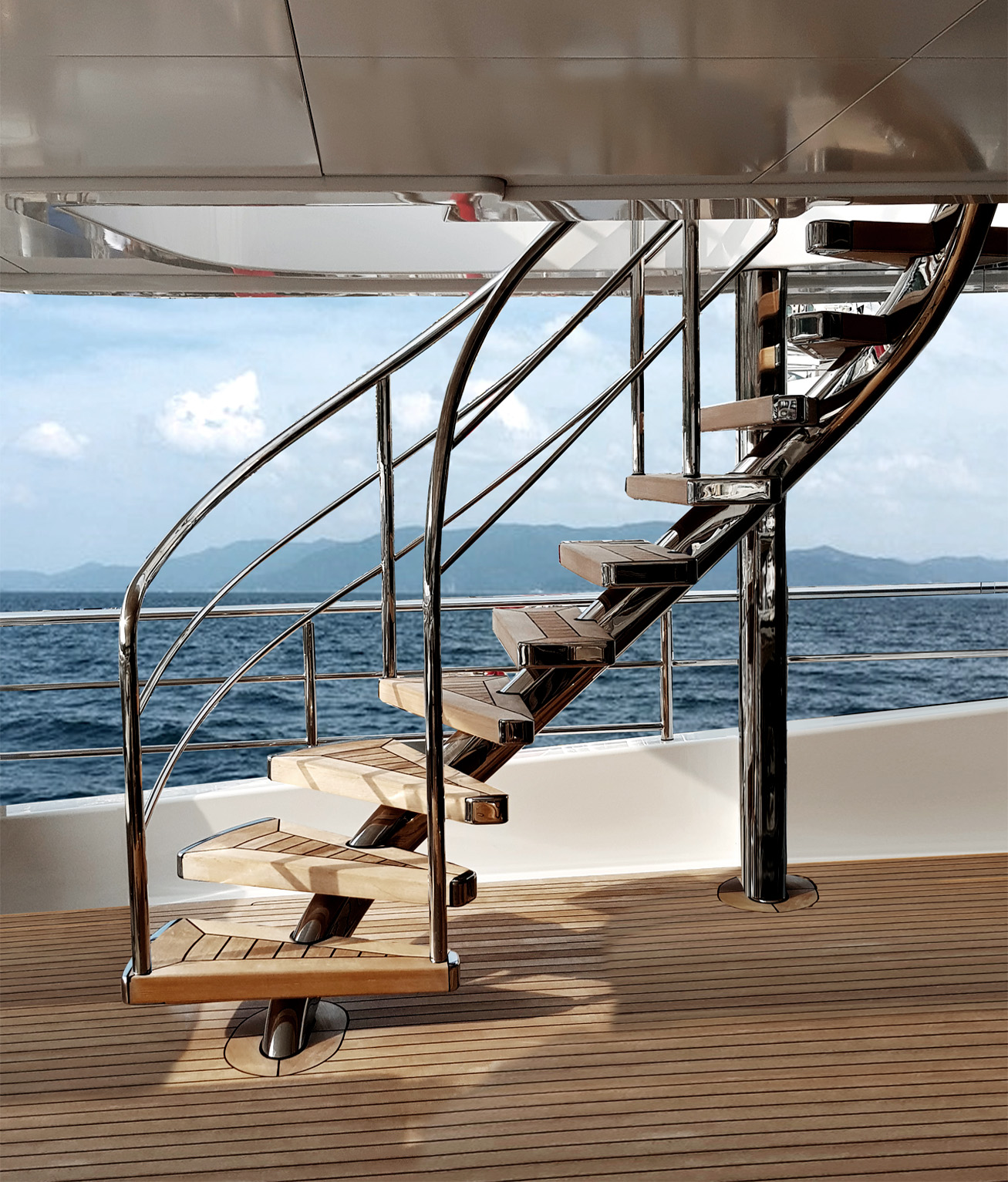
Building a yacht is a long-term project and a major investment. Our team of experts will support you to articulate your vision and put together a comprehensive and thorough brief to create the perfect yacht for you.
To bring your wishes and dreams to reality you will have at your disposal a dynamic International team, featuring award winning Italian yacht exterior and interior designers and Dutch naval architects, working together in absolute harmony. The client inspires, the designers and engineers express, and the shipyard forms, all driven by the pursuit of perfection.
Our Project Management Team will be available around the clock throughout the construction of your new build project, ensuring efficiency, cost effectiveness and resolving swiftly any challenge that may arise.
When the yacht is complete our team of experts will attend the yacht’s sea trials, during which we will make sure that any technical issue will be addressed or fine tuned to perfection before the final delivery of your new yacht.


poetry essay on tomorrow's daughters
Your browser is ancient! Upgrade to a different browser or install Google Chrome Frame to experience this site.
Lebogang Mashile
Tomorrow’s daughters.
- 1 TOMORROW’S DAUGHTERS | Translations: TÖCHTER VON MORGEN ">de
- 2 INSIDE OUTSIDER | Translations: IM AUSSENSEITER ">de
- 3 LOVE IS ELASTIC | Translations: LIEBE IST ELASTISCH">de
- 4 SISTERS | Translations: SCHWESTERN">de
- 5 I KNEW A GIRL ONCE | Translations: ICH KANNTE MAL EIN MÄDCHEN ">de
- 6 EVERY CHILD, MY CHILD | Translations: Jedes Kind mein Kind">de
- 7 TELL YOUR STORY | Translations: Erzähl deine Geschichte">de
- 8 YOU AND I | Translations: Du und ich">de
I want to write a poem About pretty black girls Who don’t relax and lie their dreams away Voices that curl The straight edges of history Hair thin slices of a movement Turning the world kinky I respect the disciplined silent screamers Who expose the holes Emily Dickinson, I am climbing through To your wooden shed of isolation Where the robin’s song Robbed you of your sanity I revere people to my own detriment Perhaps you did too But when I enter your hallowed hearth Please don’t turn me away I want to show pretty black girls How to look at their hearts With eyes blaring at full blast The way you did Together we can build a bridge To the promise in their faces And pull them towards poems By pretty black girls Wearing crowns of change
Translations:
Töchter von morgen.
Ich will ein Gedicht schreiben über schöne schwarze Mädchen Die nicht nachgeben und von ihren Träumen lassen Stimmen, die die glatten Kanten Der Geschichte wellen Haaresbreite Schnitte einer Bewegung Die die ganze Welt verdreht. Ich respektiere disziplinierte stumme Schreier Die die Löcher entblößen Emily Dickinson, ich komme geklettert Zu deinem Holzschuppen der Vereinzelung Wo der Gesang des Rotkehlchens Dir den Verstand geraubt hat. Ich verehre Leute zu meinem eigenen Schaden Vielleicht du ja auch Aber wenn ich deinen geheiligten Herd betrete Bitte schick mich nicht weg Ich will schönen schwarzen Mädchen zeigen Wie ihre Herzen anzuschauen sind Mit Augen, schmetternd, voll Wucht Wie du es tatst Gemeinsam können wir der Verheißung In ihren Gesichtern eine Brücke bauen Und sie an Gedichte heranziehen Von schönen schwarzen Mädchen Bekrönt mit der Krone des Wandels

Remember poem / Add to List
remembered 2 times
Poem already on my list
If you want to remember or list a poem, become a community member.
Random poem
Meaning of tomorrow’s daughters by lebo mashile.
"Tomorrow's Daughters" by Lebo Mashile is a powerful and meaningful piece that highlights the importance of representation and empowerment for black women. Through her lyrical prowess, Mashile addresses the struggles faced by black girls and women, while also celebrating their strength and potential.
The opening lines, "I want to write a poem / About pretty black girls," immediately establish the focus of the piece. Mashile aims to bring attention to the experiences and narratives of black girls, who often face societal pressures to conform and downplay their dreams. The phrase "who don't relax and lie their dreams away" suggests the notion of relaxing hair, a practice that historically symbolizes conformity to European beauty standards.
Mashile goes on to describe the voices of black women as ones that "curl the straight edges of history." This assertion speaks to the transformative power and influence that black women have had in shaping movements for equality and justice. By using the metaphor of hair, she portrays their contributions as a force that defies societal norms and stereotypes.
The reference to Emily Dickinson adds another layer of depth to the poem. Dickinson is known for her reclusive and isolated life, and the line "I am climbing through / To your wooden shed of isolation" not only acknowledges her struggle with sanity but also serves as a metaphorical doorway for Mashile to enter into Dickinson's world. This suggests that Mashile seeks to gain insight from Dickinson's experiences and wisdom, possibly drawing parallels between their own journeys as female artists.
The plea for acceptance in Dickinson's "hallowed hearth" emphasizes the desire for acknowledgment and validation from those who have come before. Mashile not only wants to pay homage to the struggles and accomplishments of black women who have paved the way but also seeks their support and guidance to further empower "pretty black girls."
The line "How to look at their hearts / With eyes blaring at full blast" highlights the importance of self-reflection and self-acceptance. Mashile urges black girls to see themselves not through the lens of societal expectations but with an unapologetic and confident perspective. This encouragement aligns with the central theme of the poem, which is to empower black girls by encouraging them to embrace their identity and heritage.
The reference to "a promise in their faces" suggests the untapped potential and futures that lie within these black girls. Mashile envisions a world where these girls realize their worth and use their voices to effect change. By emphasizing the power of poetry, she suggests that art serves as a powerful tool in fostering self-expression and inspiring collective action.
The closing line, "By pretty black girls / Wearing crowns of change," encapsulates the essence of the poem. Mashile envisions a future where black girls, empowered by their heritage and encouraged by the legacy of those who have come before, take up their rightful places as agents of change. The image of the crown symbolizes both their regal presence and the responsibility they carry to shape a more inclusive and equitable world.
"Tomorrow's Daughters" is a call to action, urging society to recognize the talent, resilience, and potential of black girls and women. It celebrates their unique experience while also highlighting the need for support, representation, and equal opportunities. Through her passionate and poetic articulation, Mashile offers a poignant message that encourages the empowerment of black girls and the amplification of their voices.
This meaning interpretation was written by AI. Help improve it with your feedback
More from this artist
Every Child, My Child
Lebo Mashile
I Dance To Know Who I am
I Knew a Girl Once
Tell Your Story
Trending this week
End of Beginning
Heaven Knows (The Angel Has Flown)
Orange & Lemons
- POET'S PAGE
Tomorrow's daughters, see more of poemist by logging in.
Login required!
Services on Demand
Related links, education as change, on-line version issn 1947-9417 print version issn 1682-3206, educ. as change vol.24 n.1 pretoria 2020, http://dx.doi.org/10.25159/1947-9417/7600 .
THEMED SECTION 2 ARTICLE
"That's Schoolified!" How Curriculum, Pedagogy and Assessment Shape the Educational Potential of Poetry in Subject English for Black High School Learners
Adam Cooper
Human Sciences Research Council and Stellenbosch University, South Africa. [email protected] ; https://orcid.org/0000-0003-3605-2032
This article explores the teaching of English poetry in two Gauteng high schools, one a suburban, former Model C school and another in Soweto. Both schools are attended predominantly by Black learners for whom English is not their first language. Nine in-depth, semi-structured interviews were conducted with educators at the two schools. The choice of poems, pedagogy and assessment emerged as important themes in making poetry relevant and educational in South African schools. Writers from similar backgrounds, with common "race" or class-based identities, helped make poetry relevant, but were no guarantee that learners would relate to these poets. Teaching poetry was described as an intimidating experience both for learners and educators, resulting in many teachers retreating to the safe space of a defined set of teaching practices focused on figures of speech, literary devices and a line-byline analysis of the poems. While some intentions existed to teach poetry in a way that encouraged a range of interpretations and possible answers to assessment questions, the standardised matric examination shaped pedagogical practices, as educators wanted to support learners to excel. These findings are interpreted in a post/decolonial context where a range of disparate "Englishes", identities, learners and histories exist, and neoliberal education policies and practices increasingly standardise assessment processes, with implications for the teaching and learning of poetry.
Keywords : poetry; curriculum; poetry teaching; poetry curriculum; South African schools
Language is a tool for thought and communication. It is also a cultural and aesthetic means commonly shared among a people to make better sense of the world they live in. Learning to use language effectively enables learners to acquire knowledge, to express their identity, feelings and ideas, to interact with others ... . It also provides learners with a rich, powerful and deeply rooted set of images and ideas that can be used to make their world other than it is. (Department of Basic Education [DBE] 2011, 8)
Introduction 1
The Educational Potential of Poetry
The epigraph is taken from the South African Department of Basic Education's Curriculum and Assessment Policy Statement (CAPS). It outlines the purposes of language education for secondary school learners, including sharpening their thinking and improving communication. Languages can expose learners to new ideas, expanding their worlds, inducting them into cultural and aesthetic forms that are shared among groups, including their own social groups, and in the process helping them to express their identities. The CAPS proceeds:
The main reason for reading literature in the classroom is to develop in learners a sensitivity to a special use of language that is more refined, literary, figurative, symbolic, and deeply meaningful ... . [It is] an added method of revealing, reinforcing, and highlighting their ideas. (DBE 2011, 10)
Literature is intended to expose learners to creative techniques used to enhance the ways in which ideas are shared. In this article I engage with the inclusion of one literary form-poetry-exploring how it may contribute to the objectives outlined in the CAPS statement. Research was conducted with educators at two high schools in Johannesburg: one a suburban former Model C 2 school and another in Soweto, Johannesburg's largest township. There were no white learners at either school. Nine in-depth, semi-structured interviews were conducted with educators: five at the former Model C school and four at the township school. All the educators interviewed at the former Model C school were white. Each school's English department contained eight educators in total, meaning that approximately half the English educators at the two schools participated in the study. The research with educators explored the following question: How do the curriculum, pedagogy and assessment practices shape the educational potential of poetry in subject English for Black high school learners in Johannesburg?
By "educational potential" I mean the capacity to aid the processes mentioned in the CAPS: to sharpen thinking and the ability to articulate and communicate ideas effectively, as well as to induct learners into cultural and aesthetic forms shared among groups, including their own social groups. Poetry should help to build learners' identities and help them learn about others. International and South African research on teaching poetry at schools has shown that the educational potential of poetry is not always realised.
International and South African Research on Teaching Poetry
Some international research on teaching poetry found it a difficult and alienating literary form, while other work suggests that it can helpfully bridge learners' everyday and school worlds and foster their cognitive and emotional development (Benton 1999; Doug 2011; Dykmore 2012; Linaberger 2005; Wilson 2013). In terms of negative findings, poetry's language, diction and imagery have been experienced as unfamiliar and intimidating (Benton 1984). Educators describe insecurities around analysing and interpreting poetry (Benton 1999; Linaberger 2005). Poetry is often seen as elitist; British educators reported that students complained that poetry was "posh" (Doug 2011). These class-based divisions could be even more pronounced in South Africa, where class intersects with "race", meaning that English poetry could be culturally unfamiliar and alienating.
Other research has found that educators endorse poetry as important, with its educational potential linked to emotional resonance and real-life topics. Educators in some studies said poetry was relevant to life, and that it allowed students to engage through emotional responses, rather than pure rationality (Benton 1999; Wilson 2013). Poetry catalyses imaginative inquiry, cross-pollinating more rational and scientific school subjects and tasks (Young 2016). Poetry enables personal and emotional links with poems, an unusual interaction between students and the texts they generally encounter in classrooms (Doug 2011). Poetry also encourages forms of multimodal learning, combining the written word, audible voice and bodily movement (Archer and Newfield 2014; Simecek and Rumbold 2016). It has the potential to enhance both students' classroom based and real-life literacies (Dykmoke 2012). The educational potential of poetry is therefore linked to its ability to connect with learners' emotions, as well as their lives outside the classroom. The traumatic experiences that many Black South African learners face in relation to a violent society plagued by poverty and inequality may result in poetry being an important cathartic outlet. Poetry could provide a medium through which students make sense of their daily lives, in the context of a divided and confusingly fractured society, resulting in its fertile educational potential.
While little research has been conducted on poetry teaching in South African classrooms, some work indicates that poetry may hold potential if it draws on existing cultural forms, such as praise poetry and popular culture, for example hip hop (Cooper 2016; Newfield and D'Abdon 2015; Newfield and Maungedzo 2006). Promoting multimodality is important in this regard, which means not privileging written forms over oral, visual, bodily or other forms of meaning-making. Engaging with poetry outside South African classrooms has demonstrated rich potential for learning, with multimodal classroom poetry producing similar results (Newfield and Maungedzo 2006).
Some research finds poetry to be alienating, unfamiliar and irrelevant, yet other studies indicate the opposite: that poetry may catalyse connections to learners' lives outside the classroom and tap into their emotional worlds. These paradoxical findings indicate that it may be the curriculum and pedagogy-the poems chosen and the ways they are taught-that determine the educational potential of poetry.
Culturally Relevant Pedagogy
While English poetry may be alienating because it is not taught in the mother tongue of the majority of South African learners, research on Culturally Relevant Pedagogy (CRP) hints that English poetry may still have educational potential for Black South African learners. Poetry has the ability to make links with learners' everyday lifeworlds, a central focus of research on CRP. Under the banner of CRP or asset-based pedagogies, research in the United States of America has shown that meaningful classroom learning and improved academic outcomes can be attained by resonating with students' funds of knowledge (Moll et al. 1992): their cultural resources, values, worldviews and experiences. This approach refutes marginalised students' cultural resources as deficient or a hindrance to learning (Gonzalez and Moll 2002; Lee 2007; Moll et al. 1992). Instead, links between students' out of school resources and discipline-specific school learning are encouraged in efforts to enhance the education of marginalised and minority youth (Ladson-Billings 1995; Lee 2007; Moll et al. 1992). CRP aspires to integrate the values, practices and experiences of marginalised groups into the pedagogical process, drawing connections between reference points that students bring to classrooms and the knowledges and practices that they encounter at school (Moll et al. 1992; Ladson-Billings 2009). This has been shown to improve their self-esteem, interest in academic work and relationships with educators (Gay 2000; Howard 2001; Leonard and Hill 2008). Common themes in poems, such as apartheid, as well as the origins of the poets and the contexts they write about, have close connections to the real lifeworlds of Black South African learners, implying that teaching poetry may be highly relevant and beneficial.
Exploring forms of CRP through poetry could be a timely intervention in South Africa, as poetry teaching has shown rich promise for Africanising and decolonising curricula, which is sorely needed (D'Abdon 2016). Nationwide student protests at South African universities in 2015 and 2016 critiqued the colonial, irrelevant nature of university curricula. Black students felt that universities remain dominated by lingering colonial practices and knowledges, resulting in alienating and uncomfortable educational experiences. The protests have sparked research in multiple academic disciplines into what it means and takes to "decolonise" a curriculum. These protests raise the question of whether high school curricula, pedagogies and institutions are similarly plagued by forms of coloniality. While poetry may be considered a foreign genre with colonial connotations, linked to its classic forms as practised in Europe, a large body of local poetry exists, including poems by Black South Africans, indicating that it could be used to decolonise curricula.
South African poetry could be considered a form of indigenous knowledge with rich educational potential. This notion of indigeneity links knowledge forms and practices to the places where they are produced, rather than advocating for a form of essentialism. African poetry as indigenous knowledge is place-based and Africa-centred, historically forged but fluid and changing (D'Abdon et al. forthcoming). Poetry as indigenous knowledge draws on a range of linguistic and stylistic traditions and choices, with both local and global connections (D'Abdon et al. forthcoming). As a body of work, South African poetry is forged in the settler-colonial, apartheid and post-apartheid experiences, calcifying droplets of knowledge through poetry, a living archive of these interactions (D'Abdon et al. forthcoming). Here I explore the relationship between poetry, place and notions of indigeneity, asking how learners' perceptions of poems, poets and place shape what and how they learn from poetry.
To sum up, poetry holds rich educational potential to connect with learners' everyday lives in meaningful ways and to engage them by transcending purely rational and cognitive forms of inquiry, delving into emotional domains through multimodal methods of teaching and learning. This is particularly relevant in a society with traumatic circumstances and histories, such as South Africa. Despite this fertile potential, some research has found that educators struggle to teach poetry and learners experience it as elitist, unfamiliar and alienating. Connections between poetry and forms of Culturally Relevant Pedagogy highlight the potential to link learners' lifeworlds to the classroom, simultaneously prioritising their academic success and socio-political consciousness. This may be particularly useful in South Africa, where university students have recently dismissed curricula and teaching as underpinned by colonialism, rather than familiar cultural reference points. I explore how this may be achieved by delving into poetry curricula choices as well as educators' teaching and assessment practices in two high schools in Johannesburg.
Producing Poetic Data: Research Contexts, Interviews with Educators and Analysis
As mentioned, the research formed part of a broader project led by the South African Poetry Project (ZAPP), a collective of poetry practitioners, scholars and educators. Some educators have been drawn into the ZAPP network through their postgraduate studies at the University of the Witwatersrand, where they met academics involved in the network. A group of these educators, along with poets and academics, attend ZAPP meetings. During one of these meetings, educators from two schools volunteered their schools as research sites. The educators then introduced the research team to school management and staff and facilitated interviews with their colleagues in the English departments, as well as interactions with learners who were participating in extracurricular poetry activities.
The large, former Model C school is located in a suburb approximately 20km from central Johannesburg. It had an all-white student body in 1994, but is now attended exclusively by Black students. The Soweto school is also located approximately 20km from central Johannesburg and is attended mainly by isiXhosa-speaking and, to a lesser extent, SeSotho-speaking learners. While few of the learners at either school came from English-speaking households, learners at the former Model C school had greater English resources at their disposal and were more affluent, relatively speaking, than learners who attended the school in Soweto.
The research project was described to educators at the two schools at an English department meeting and educators were then requested to volunteer if they were prepared to participate in an individual interview. The nine in-depth, semi-structured interviews took place in empty classrooms after school, lasting approximately one hour each. Interviews were fairly open-ended, allowing the participants to interpret the questions on their own terms (Burman 1994). An interview schedule was roughly followed, probing a range of areas related to the teaching of poetry in classrooms. Interview questions explored where they have studied, heard and read poetry (inside and outside formal tuition spaces), which poems they find rewarding, challenging or unpleasant to teach, their aims, experiences and methods in teaching poetry and which poems they believe students enjoy the most.
The interviews were transcribed in full and a thematic analysis was conducted, identifying key themes in the transcripts, guided by Braun and Clarke's (2012) approach. This involved becoming familiar with the dataset as a whole and an initial generation of codes, used as the basis for identifying key themes. Interpretations were then made, assessing the relevance of these themes in relation to the dataset as a whole, the research question and contexts (Braun and Clarke 2012). A descriptive account of the findings was produced, with the key themes of the curriculum, teaching methods and assessment standing out from the initial analysis. These themes were then interpreted using relevant theoretical and analytical concepts and frameworks. The research project was approved by the ethics committee of the relevant institution and the confidentiality of all participants was maintained.
Findings from the Research
Theme 1: "The Moment There Is Something They Can Relate to It Opens up the Conversation": Curriculum Choices and the Relevance of Poetry
The first issue that shaped whether poetry resonated with learners at both schools was the difficulty of the language contained in the poems. An educator at the township school said:
It's a language issue. Low English. Most of the poems in the syllabus, yoh they're hard; they completely turn them off poetry, which is terrible. Kids with higher English do well. Even them, if you not thinking, writing, being creative in English every day, even English first language kids are turned off ... . [It's a] way of thinking and expressing they're not familiar with ... . If it's clearly a love poem or a self-affirmation poem that's the genre and the language is clear, then kids can really connect with that.
As this educator explained, even mother tongue English-speaking learners regularly struggle with language used in poetry, so non-native speakers are not likely to be enticed to explore these cultural artefacts and students at township schools really battle to understand the poetry set in the curriculum. Not only is the vocabulary often difficult, poetry contains a "way of thinking and expressing" that is unfamiliar to township learners. Educators at the former Model C school expressed similar sentiments:
"Eating poetry" [a poem by Mark Strand], they don't have a flipping clue. It's on a different level. They don't relate to it. "London" by William Wordsworth goes right over their heads. Not relevant to our learners. So you spend the entire hour explaining content to them and never get to that point where you can actually enjoy poetry. I actually think we should incorporate some of their musicians.
The language used, the genre of poetry, the poets and their contexts, such as Wordsworth in London, contribute to learners' inability to "relate" to the poem. Educators spend the vast majority of their time explaining what individual words mean and providing learners with information on the cultural context, inhibiting pleasure in poetry. This educator indicated that connecting with learners' cultural resources, "their musicians", may help to alleviate this discord. The concept of relevance appeared regularly in the interviews. One educator described relevance as follows:
I would have poetry that deals with issues more relevant to young people; they respond to those poems better. It comes back to their frame of reference. . But we cannot just expose them to that. I suppose that's why we still do Shakespeare. ... I would keep the mixture of poetry but would change the balance. More South African and African writers and poetry. They respond so much better. So much more participation and questions.
This educator grappled with the issue of relevance, explaining that the poetry curriculum should address familiar topics, but that learners also need to be exposed to issues that may be beyond their immediate reference points. Her mention of Shakespeare is probably due to the assumption that he engages with universal and timeless themes such as love, justice and betrayal. In the interview she realised through reflection that the same themes can be found in African texts and that these local texts are less difficult for learners to comprehend than Shakespeare. She concluded that a balance of local and international authors should be included in the curriculum and that the weighting is currently skewed in favour of authors from elsewhere. Her experiences of teaching African and South African poetry led to her view that students relate better to local poetry, with increased participation and greater willingness to engage in dialogue through questions. Relevance is therefore both related to individual poems connecting with the challenges learners face, as well as a broader issue related to the composition of the curriculum as a whole and the overall flavour of its content. She highlighted that relevance requires both familiar authors and topics, but also new ideas. Relevance was often complicated:
For poetry to be interesting they need to read poets from similar backgrounds to them. Role models in their types of communities. [But] just to say we need more African poets or more Black poets, it's not getting to the complexity of the issue. Cause you bring like Koleka Putuma poem and it's amazing ... that type of poet, like Model C school bam nails it, but here that English level and way of speaking and even some of the issues, they're not the same issues, they may be connected ... but just because a person's Black and has a history of being oppressed by white people, it doesn't mean that people are experiencing that in the same way.
This township school educator explained that poets who originate from similar backgrounds to learners help to promote poetry and make poetry relevant. However, prominent poets who grew up in the townships usually progress in their education beyond the levels reached by most township children; their knowledge of English develops exponentially and they are exposed to new contexts due to their professional success. Simply matching township schools with poets who began life in the township is therefore no guarantee that learners will relate to the work these poets ultimately produce. This educator therefore felt that, as these poets become more middle class and cosmopolitan, their work is more likely to resonate with learners at former Model C schools. Township learners will not necessarily relate to their poetry, even if they share a "racial identity".
Further insights into poetry's relevance are illuminated by one poem that educators believed learners loved and another that they felt learners disliked intensely:
I did a poem by Lebo Mashile "Tomorrow's Daughters" ... that thing. We spent 4 periods; we were meant to spend two. I try to have flexibility when it' s touching the kids. The moment there is something they can relate to it opens up the conversation. A lot of the SA poems they get it, but like the English poets, we have to do sonnets, they are tested on the Italian and the Shakespearian sonnets and that kind of poetry they battle with. I also have to research those poems a lot. I teach African and South African; we teach Achebe. I relate better to that kind of poetry, so I teach it better.
Lebo Mashile's "Tomorrow's Daughters" was described by three of the five educators at the former Model C school as a poem that formed part of the curriculum and excited learners. Unlike Shakespearean sonnets, "the language, the concepts, the ideas, the themes" of this poem are accessible to learners. It also offers a rich reservoir of meaning in terms of the themes alluded to in its figurative language, its politics and cross-references to other poets. The educator mentioned Achebe as another author whom she enjoyed teaching, illustrating the relevance of African authors in these South African classrooms.
The choice of poems also needs to be considered in relation to the curriculum as a body of work:
Next year I'm in charge of Grade 10 so I'll do it a bit differently. Because of the poems that were chosen, it's either political or extremely depressing. Whereas when they choose something by Keats, Byron, Wordsworth, they go for something about love, nature. Which I think does both of them an injustice, I don't think it gives a complete or nutshell picture.
Caricaturing African and South African poetry as only engaging with politics, while Western poetry addresses the themes of beauty, nature and love, misrepresents the entirety of these bodies of work. It also problematically insinuates that while Western poets deal with universal themes of nature, love and beauty, Africans only engage with local political conflicts such as apartheid.
There was evidence that educators found international poems that could stimulate "relevance":
Interviewer: Can you name a difficult poem to teach?
Interviewee: "London, 1802." He writes about Milton and I really struggled to get them to turn on because it was so removed from their political culture. Removed from their time. ... Then we did "Next, Please", but they responded to it better because the abstract theme in it was something they could identify with. The language in "London" was high but that wasn't the problem and they didn't do too badly on it in the test, they just studied the poem like a parrot. . I wish I could have done something with them that was a bit more relevant. And by relevant I don't mean more modern or even South African necessarily, just relevant to them.
Poetic relevance is not necessarily tied to place of origin or the identity of the author. This educator explained that Larkin's "Next, Please" was popular among the learners because they could relate to the universal theme and the language was accessible. However, Wordsworth's "London, 1802" required a great deal of contextualisation in terms of the changing values the poet felt were being eroded with the emergence of industrial society. The context in which that poem was written and the themes that it spoke to had little connection to Black high school learners in post-apartheid South Africa. Another difficult issue that further complicates the teaching of poetry, explored more substantially in the next section, is that good teaching takes time. The issue of morals and values is timeless, but to make "London, 1802" relevant would require detailed history lessons and an understanding of the poet's context. In this sense "relating to their own lives" is not simply about the themes being the same, such as morality, but the ways in which these themes play out in their particular historical context. The fact that "Next, Please" by Larkin was relevant to learners implies that relevance is not only about place or the origins of the poet, but is also linked to the pedagogy used and how educators help learners to find relevance as they navigate the distance between their own time and place and that of the poet.
Relevance was a complex issue related both to individual poems and to the corpus of poetry that was presented to learners as a whole. The accessibility of the language clearly impacted on relevance, as second- or third-language speakers not comprehending the vocabulary of the poem resulted in alienation. Writers from similar backgrounds, with common "race"-based or class-based identities, helped make the poetry relevant, but were no guarantees that learners would relate to these poets: the poets may have left the township, or may no longer focus on its cultural reference points. Educators were aware that African and South African poetry was more likely to resonate with learners, but stressed that it was good for them to experience other cultures and perspectives. Educators were reticent to perpetuate stereotypes of Western poetry dealing with universal issues and African poetry only addressing politics. It became clear in the research that relevance was not related to curriculum choices alone, but was forged in the relationship between curriculum, pedagogy and assessment.
Theme 2: Grasping at Figures of Speech: Poetry Pedagogy
Most of the participant educators said that they used a structured process to teach poetry, including a focus on poetic devices and figures of speech, as well as line-by-line analysis. One educator explained:
If they don't know figures of speech it's going to be difficult for them to engage ... . Poetic devices and figures of speech we do at Grade 8. So as they reach Grade 12 it's easier to understand. Then we go to the lines in the poem; what is the implication, what is the message, what is the poet trying to teach us. Then the learners get interest cause they compare it to their life situation. Cause once they get interested it's easier. But if you make it difficult, they won't like poetry.
Difficult vocabulary and an alien literary and cultural form led this educator to believe that breaking the process down into a number of constituent parts can enable learners to understand poetry better, generating interest. He stated that this method prepares learners for a high school experience in which poetry is an annual event, meaning that poetic devices and figures of speech provide scaffolding that can be reused and built upon as learners progress in their secondary schooling. Other educators stated that the use of these devices was for the benefit of the educators, rather than the learners:
I find it easier to teach those kinds of structures in that poetry. They're easier for teaching. That's what I feel.
Another educator agreed that the use of this highly structured teaching style helped with her insecurity around teaching poetry:
They have to number their lines. I read through the poem or one of them reads through it first. Then we'll do the structure of the poem, what is the line structure what is the stanza structure. We have a little structure bubble. Some of them come to class with their numbered lines and little structure bubbles. We discuss the vocabulary. Then we do a line-by-line breakdown. Line 1 what figures of speech, literary techniques. Then I ask them so what do you guys think this poem is about, but we don't discuss it in too much depth. I think I'm a bit insecure of teaching, I didn't do a 4-year B.Ed. So I constantly check with other educators and kids.
One of the difficulties of teaching poetry is that it is an interpretive, fairly abstract literary form, without a linear format and a singular, clear piece of knowledge that can easily be conveyed to learners. This means that the educator easily loses control of the pedagogical process in poetry teaching: they are unaccustomed to teaching this genre and it provokes anxiety. This is particularly the case for educators who feel they have not had adequate training, such as the educator above. One way of countering this insecurity is to construct a structured method for teaching poetry, a set of practices that can easily be replicated and repeated and which ensures that, at a minimum, the learners leave with a set of notes that provide evidence that teaching has taken place. Learners' written work can be used to demonstrate to school management and education department personnel that the educator is performing efficiently.
One of the problems with this approach is that poetry becomes characterised by attempts to identify correctly whether a figure of speech is, for example, a metaphor or a simile, rather than a focus on interpreting the meaning of the poem. An educator said:
I show them that our perceptions of the poem will be different and also the different figures of speech might be different ... for example the same line could be personification, can be metaphor, or hyperbole and all of us are right. So the whole point of that is that I want us to approach the poem from our own perspective and we must try analyse it. ... I'll ask them to pick up that metaphor but there will always be a child who picks up the personification so we'll have that discussion and as long as they can justify it then I welcome conflicting views.
While the educator above does indicate that she encourages different interpretations of the poem, her description indicates that the lesson centres on interpretations of the figures of speech. The purpose of the poem, the intentions of the poet and the ways in which he or she uses these devices become peripheral to the exercise; the priority shifts to breaking the poem down into its constituent parts, so that it becomes manageable and "teachable". The focus is transferred to the parts-in this case the figures of speech- rather than the meaning of the whole poem, with the primary concern being to identify and classify these correctly. Rather than using the figures of speech to help understand the poem, the figures of speech become the focus of concern in and of themselves. Poetry becomes a technical exercise to identify forms of language, rather than fulfil the aims of the CAPS, which state that poetry should aim to develop learners' identities, learners should learn about others and be exposed to new ways of expressing their ideas. One educator expressed his frustration with this state of affairs:
Interviewee: Using poems to explain figures of speech . is not a poem. It's a tickable term that's going to be tested in the exam. Who the hell writes a poem for great examples of metaphors? The way we study in a very theoretical, disconnected nature in school and make it a real thing. Poetry is an artistic expression, is a social behaviour, social event. It is a social practice, it's creative. Interviewer: Why is it that way in school? Interviewee: Because of the way the education system is in a long history that comes from a different tradition of poetry really. Or a tradition that favoured the written poetry as opposed to performed poetry. At some point people decided . English educators in schools decided that poetry was a good thing to have in it. But so few of those people have ever been exposed or interested in real poetry, or been to poetry recitals or heard poets speak. So they don't know actually poetry is that. You'll often hear teachers say we need to know the figures of speech. That's like you make a system into it. That's schoolified. School needs to take things in the world and like make points on them. . The irony is you just learn the constituent parts, but you don't put them into the whole again.
Part of this participant's frustration with teaching poetry at school is that what he calls "a real thing"-an active event or process-becomes transformed and divorced from its original context. In the process poetry changes from something that is alive- performed, and embodied-to dead words on a page. The reasons for "killing" poetry in this way are multiple, including some already alluded to, such as breaking poetry up into parts and focusing on specific devices that help to interpret lines of the poem, but not necessarily understand its overall meaning. Through this process, poetry teaching is based on strategies to pass tests, rather than, in line with the ambitions of the CAPS, to build learners' identities and help them to find creative and novel ways to express their thoughts.
One of the difficulties described in this process is that a necessary change of context occurs when poetry is transferred from the poet's studio, a performance space or reading room and placed in the school context. At school a certain amount of standardisation is required across the system; schools operate in rule-governed environments and they are controlled by the auspices of the state, all of which stifle and repress creativity, spontaneity and individuality. The process of "schoolifying" poetry operates to homogenise the process, in direct contradiction to the logic and purpose of poetry. Repeated readings of a poem are never identical and do not aspire to be so. However, the school system works to make things the same, uniform, with textbooks and memoranda that educators use to mark assignments. The ever-looming spectre of assessment had a considerable impact on how poetry was taught at the two schools.
Teaching poetry was described as an intimidating experience both for learners and educators. Confronted with this challenge, many educators retreated to the safe space of a defined set of teaching practices focused on figures of speech, literary devices and a line-by-line analysis of the poems. While some educators said that this made learning easier and that they could build on this knowledge in the future, these practices clearly also aided them. One educator was particularly vocal in his critique of poetry teaching at school, describing it as similar to other school learning processes that extract a practice and knowledge from its natural context, decontextualising and breaking it up into pieces, standardising it so that it is unrecognisable from its original form.
Theme 3: "There Are Some Teachers Who Won't Teach If They Don't Have a Memo": Assessment
In South Africa, secondary school culminates with the matric examinations, the most important set of assessment tasks that determine whether or not learners may continue with tertiary studies. Preparing learners for poetry in the matric examinations was described by one educator as follows:
Interviewee: With the matrics you have to prepare them for the final exam, so it's out of our control, although we know more or less what they will ask. That's also something I try not to do. Interviewer: Teach to the test? Interviewee: You do that with your matriculants. You know what questions they're going to ask. There won't be questions outside of the parameters of the study guide. We make copies of the important notes.
This educator admitted that although she tried to avoid "teaching to the test" in general, this is largely not possible for the matric learners. A lot is at stake in matric and many educators feel they will be doing their learners a disservice if they do not utilise practices that are likely to improve learners' results, even if these are anti-educational, such as reproducing and disseminating study guides. A fairly standardised, consistent set of questions is posed in these examinations, issues that are outlined in the above-mentioned "study guide". Educators can transcribe notes and ensure that all the learners have access to these "answers" prior to the exam. Standardised answers for poetry assessment questions were also evident in the fact that a number of educators mentioned "the memo" or memorandum, a document constructed and shared between educators that details acceptable answers to examination questions. Memos are constructed by English department educators to act as standardised, acceptable answers for tests and are then used across multiple classes. In the case of matric, memos from past examinations are distributed to schools, as educators revealed:
There are some teachers who won't teach if they don't have a memo. So they going to want to have a feeling of what the answers would be to the questions, obviously so that they can go through them for their classes. But that depends on your experience and approach to poetry. I see poetry as open to interpretation and that's how I introduce it to the Grade 11s, how poetry can change perspectives. Whereas there are other teachers who want to know that this can only be a metaphor and if it can be anything else then that must also be on the memo. It comes down to experience and it comes down to just level of knowledge you have with regard to genre, that type of poetry, and that poet.
And then we have a memo meeting and I'll say this is also another way of looking at it and the child has responded. Very often we can't accept that second answer. So if we gonna teach the children "be open minded, it' s open to your interpretation", then we need to include that in the memo. In our memo discussions, we are a bit too rigid in terms of what we expect.
There was evidence in the research that educators often had good intentions to teach in an open-minded way and accept a range of interpretations for examination questions, but in practice this was made difficult by the construction of memoranda with prescribed examination answers. Many educators then worked backwards, using these memos in future classes to ensure that learners had access to the "correct" answers, inhibiting the possibility of teaching poetry in a more dynamic, interpretive, multimodal and experiential manner. The educator above indicated that this pedagogical method was due to anxiety and a lack of experience, rather than a belief that this is the only acceptable method. The fact that educators explained to the learners that, as readers of poetry, they need to be open-minded, indicates that a will existed to teach in an alternative manner. However, the reality of school life, including the pressures of examinations, the desire to be fair to all learners by having standardised answers and the fact that educators have different levels of experience, all mean that "the memo" is often retained as an invaluable tool that structures the teaching of poetry. This resulted in the subject of English being perceived in a certain light:
It's as if the English curriculum is structured around teaching them the facts. English has become a study subject like history. You get the poem; you get the notes. You study those notes, write the test. You study notes from the textbook and go and write on what you studied. Instead of feeling the language on your mouth and watching it on paper and becoming comfortable in that skin or in that tongue, to speak in that tongue. So no, I don't think they express themselves.
Similar to the educator who critiqued how poetry becomes "schoolified", this educator described how poetry is learnt on paper rather than on the tongue; it is a disembodied and uncomfortable experience, one that is largely alienating for the learner. This means that learners do not express themselves in poetry, or English for that matter, as they are reduced to automatons that are simply required to memorise and repeat what they are given in the notes and the textbook. One educator lamented how this teaching and learning process compared with her own university education, expressing disappointment in school education:
I struggle. I really really struggle. One thing I enjoyed about varsity is that I felt like this is for you and the world. It was enrichment. If you want to pass, tell me why it's a good poem. Not tell me ABC.
What does it mean that poetry is "for you and the world"? It implies that, rather than its purpose being to demonstrate that a learner can memorise certain answers and recite them, the process is designed to give learners agency, to encourage them to build a relationship with the poetry and the poems and create their own answers.
While some intentions existed to teach poetry in a way that encourages a range of interpretations and answers to assessment questions, the standardised matric examination shaped pedagogical practices around this event, as educators wanted to support learners to excel in this ordeal. Participant educators indicated that standardised assessment procedures went beyond the matric examination, as it appeared that a "memorandum" was created for school tests and examinations. Desired answers were pre-recorded on this document as the only acceptable responses, limiting learner agency and the freedom to produce alternative interpretations of the poems.
Discussion: Finding the "Poetry of Poetry" in a Neoliberal Education System
Research with educators teaching Black learners in Johannesburg found that the choice of poets and poems, combined with teaching and assessment methods, significantly shaped the educational potential of poetry. It highlighted that the curriculum, pedagogy and assessment need to be focused on collectively if the teaching of poetry is to become a form of Culturally Relevant Pedagogy. Choosing empowering poems will not be effective if they are taught and assessed in ways that do not elicit connections with the lives of learners. Similarly, methods of teaching and assessment require a body of poems that speak to the issues and worlds inhabited by learners.
While English poetry clearly has the educational potential to make connections to learners' everyday lives, stimulating interest and classroom-based discussion, this finding was not always true across the poetry curriculum or for both schools in the study. The teaching of certain poets and poems was described as unintelligible, irrelevant and boring for learners. The accessibility and the relevance of poetry were first and foremost related to the language used in the poems and the difficulty of the vocabulary for learners studying in a language that they do not speak at home, despite it being their language of instruction at school. This intersected with the topics and contexts that the poems engaged with and the origins of the authors, as certain poems were experienced as radically unfamiliar and difficult for students to understand. Writers from similar backgrounds to learners helped make the poetry teaching more relevant but did not guarantee that the poetry would resonate with learners. Similarly, the fact that a poet originated from an unfamiliar context would not necessarily occlude the relevance of their work for South African learners. Educators felt that it was important for learners to be exposed to international poets, highlighting perspectives from elsewhere. A feeling existed that a balance was required from the curriculum, with a substantial body of South African and African poetry needed to make the material relevant for learners. That said, educators warned against creating a binary between foreign poetry that engaged with "universal issues" and South African poetry that spoke to "local politics". The issue of "relevance" was central to these debates in the eyes of educators, who believed that it was tied to the contexts, authors and themes dealt with in the poetry.
The poetry of certain South African poets provided a fertile space for promoting a form of Culturally Relevant Pedagogy. Lebo Mashile's "Tomorrow's Daughters" clearly struck a chord and inspired learners, connecting classroom learning to relevant issues in their lives. "Tomorrow's Daughters" was written by a young Black South African woman and addresses the issue of young Black women becoming poets, delving into issues of racism, sexism, norms about bodies, who speaks and who is recognised. The poem exemplifies for learners that people like them can become creators of knowledge used in school textbooks and that poets can highlight issues that are relevant to their lives, including racism, social norms pertaining to bodies and the silencing of certain voices. The poem is intended to provoke socio-political consciousness, an integral component of CRP and forms of critical pedagogy that aim to explore how teaching and learning can be used to validate the experiences and perspectives of learners who are marginalised in their daily symbolic and material interactions (Giroux and Simon 1989; Ladson-Billings 2014). But the poem also makes links to other contexts, namely Emily Dickinson in nineteenth-century America. CRP is therefore not necessarily insular; it does not only address learners' cultural practices and reference points. It also holds the potential to expand their worlds and transport them to new places.
Curriculum choices that impact on the educational potential of poetry cannot be analysed independently from teaching and assessment methods. Many educators did not feel confident teaching poetry. To deal with their lack of trust in themselves, they sought refuge in the more comfortable mode of breaking poems down into manageable pieces, identifying figures of speech and helping learners to understand individual lines rather than poems as a whole. Educators were honest that these practices were not only for the benefit of learners, but also for themselves. It was acknowledged that teaching underpinned by study guides and assessment dominated by memoranda are problematic and anti-educational, but educators feared that they would leave their students at a disadvantage if they did not provide them with access to these resources that apparently helped distribute the "knowledge" needed to pass examinations.
The centrality of high stakes testing is indicative of the infiltration of neoliberal ideology and values 3 into education systems in South Africa and elsewhere, presenting considerable challenges to teaching poetry in a way that is meaningful and empowering for learners. Regular inspections of workbooks by education department officials, the high stakes of standardised tests and the practice of producing memoranda with official answers further illuminate the negative effects of neoliberal policies and practices on poetry teaching. Similar findings have been observed elsewhere. Increasingly standardised assessment regimes in the United Kingdom (UK) and New Zealand have restricted the space for the teaching of poetry (Dymoke 2012). A follow up to an earlier study of poetry teaching in the UK found that educator concerns about examinations, syllabus content and time pressures were far more pronounced 16 years later, indicating that neoliberal policies and practices have had a negative effect on poetry teaching (Benton 1999).
Neoliberalism is not solely to blame for this state of affairs, as educators' insecurities about poetry teaching impacted on their practices, as demonstrated in the current study by their focus on "line-by-line" analysis and the concern with teaching figures of speech. Xerri (2013) argues that while students and educators blame assessment for the problematic way that poetry is taught in the classroom, they collude in the process. They do so by continuing to imagine poetry as an obscure literary form and by employing conventional analytical methods based on the search for hidden meaning rather than experiencing "the poetry of poetry". In Xerri's (2013) opinion, breaking poems down into individual lines destroys these literary artefacts. Neoliberalism has impacted on pedagogy and assessment practices, with negative effects on learning areas like poetry, which relies on emergent processes that lead to a range of different interpretations. However, educators collude in these processes, not necessarily because they lack effort, but due to insecurities around teaching poetry and their fears that they will not prepare students adequately.
The combination of curricula choices, pedagogy and assessment practices influenced learners' experiences of poetry in the classroom and its relevance to their lives, including their educations. If poetry is to become a form of CRP and fulfil the objectives of the CAPS, these three aspects-that form part of a unified educational process-need to be focused on collectively. Poems with great potential to engage and stimulate learners will have little effect if they are only taught by analysing figures of speech in a "line-by-line" fashion. Similarly, methods of teaching that allow learners to experience "the poetry of poetry", while also generating insights into the techniques used by poets, are unlikely to engage learners if the poems chosen for analysis are irrelevant to their worlds. If the sole intention of educators is to prepare learners for standardised examinations, it is also unlikely that the educational potential of poetry will be realised. This is not to say that examinations are irrelevant to learners, as they form an integral part of successful social mobility. It is to advocate for poems and methods of teaching that expose learners to the poetry of poetry, help build their identities, give them tools to express their ideas creatively and aid in their academic success. All of these are integral theoretical tenets of CRP and the South African curriculum outlined in the CAPS documents. This should be done while being mindful of the local and broader, global contexts in which education systems play out.
Archer, A., and D. Newfield, eds. 2014. Multimodal Approaches to Research and Pedagogy: Recognition, Resources, and Access. New York, NY: Routledge. https://doi.org/10.4324/9781315879475 . [ Links ]
Benton, P. 1984. "Teaching Poetry: The Rhetoric and the Reality". Oxford Review of Education 10 (3): 319-27. https://doi.org/10.1080/0305498840100310 . [ Links ]
Benton, P. 1999. "Unweaving the Rainbow: Poetry Teaching in the Secondary School". Oxford Review of Education 25 (4): 521-31. https://doi.org/10.1080/030549899103964 . [ Links ]
Braun, V., and V. Clarke. 2014. "What Can 'Thematic Analysis' Offer Health and Wellbeing Researchers?" International Journal of Qualitative Studies on Health and Well-Being 9 (1): a26152. https://doi.org/10.3402/qhw.v9.26152 . [ Links ]
Burman, E. 1994. "Interviews". In Qualitative Methods in Psychology: A Research Guide, edited by P. Banister, E. Burman, I. Parker, M. Taylor, C. Tindall, 49-72. Buckingham: Open University Press.
Cahnmann-Taylor, M. 2009. "The Craft, Practice, and Possibility of Poetry in Educational Research". In Poetic Inquiry: Vibrant Voices in the Social Sciences, edited by M. Prendergast, C. Leggo and P. Sameshima, 13-30. Rotterdam: Sense Publishers.
Cooper, A. 2016. Dialogue in Places of Learning: Youth Amplified in South Africa. London: Routledge. https://doi.org/10.4324/9781315638775 . [ Links ]
Byrne, D. C., R. d'Abdon, and D. Newfield. Forthcoming. "Living Archives and the Project of Poetry Recurriculation in South Africa". Scrutiny2: Issues in English Studies in Southern Africa.
D'Abdon, R. 2016. "Teaching Spoken Word Poetry as a Tool for Decolonizing and Africanizing the South African Curricula and Implementing "Literocracy". Scrutiny2: Issues in English Studies in Southern Africa 21 (2): 44-62. https://doi.org/10.1080/18125441.2016.1192676v . [ Links ]
DBE (Department of Basic Education). 2011. Curriculum and Assessment Policy Statement Grades 7-9: English Second Additional Language. DBE: Pretoria. Accessed December 1, 2020. https://www.education.gov.za/Portals/0/CD/National%20Curriculum%20Statements%20and%20Vocational/CAPS%20SP%20%20SAL%20ENGLISH%20GR%207-9%20%20web.pdf?ver=2015-01-27-155912-827 .
Doug, R. 2011. "The British Schools' National Curriculum: English and the Politics of Teaching Poetry from ' Different Cultures and Traditions'". Journal of Curriculum Studies 43 (4): 439-56. https://doi.org/10.1080/00220272.2011.576772 . [ Links ]
Dymoke, S. 2012. "Opportunities or Constraints? Where Is the Space for Culturally Responsive Poetry Teaching within High-Stakes Testing Regimes at 16+ in Aotearoa New Zealand and England?" English Teaching: Practice and Critique 11 (4): 19-35. https://doi.org/10.1080/1358684X.2012.736741 . [ Links ]
Gay, G. 2000. Culturally Responsive Teaching: Theory, Research and Practice. New York, NY: Teacher's College, Columbia University. [ Links ]
Giroux, H., and R. Simon. 1989. "Popular Culture as a Pedagogy of Pleasure and Meaning". In Popular Culture: Schooling and Everyday Life, edited by H. Giroux, R. Simon, 1-29. New York, NY: Bergin and Garvey.
González, N., and L. C. Moll. 2002. "Cruzando el Puente: Building Bridges to Funds of Knowledge". Educational Policy 16 (4): 623-41. https://doi.org/10.1177/0895904802016004009 . [ Links ]
Howard, T. C. 2001. "Telling Their Side of the Story: African American Students' Perceptions of Culturally Relevant Teaching". The Urban Review 33 (2): 131-49. https://doi.org/10.1023/A:1010393224120 . [ Links ]
Ladson-Billings, G. 2014. "Culturally Relevant Pedagogy 2.0: Aka the Remix". Harvard Educational Review 84 (1): 74-84. https://doi.org/10.17763/haer.84.Lp2rj131485484751 . [ Links ]
Ladson-Billings, G. 1995. "Toward a Theory of Culturally Relevant Pedagogy". American Educational Research Journal 32 (3): 465-91. https://doi.org/10.3102/00028312032003465 . [ Links ]
Ladson-Billings, G. 2009. The Dreamkeepers: Successful Teachers of African American Children. New Jersey: John Wiley and Sons. [ Links ]
Lee, C. D. 2007. Culture, Literacy, and Larning: Taking Bloom in the Midst of the Whirlwind. New York, NY: Teacher's College Press. [ Links ]
Leonard, J., and M. L. Hill. 2008. "Using Multimedia to Engage African American Children in Classroom Discourse". Journal of Black Studies 39 (1): 22-42. https://doi.org/10.1177/0021934706292296 . [ Links ]
Linaberger, M. 2004. "Poetry Top 10: A Foolproof Formula for Teaching Poetry". The Reading Teacher 58 (4): 366-72. https://doi.org/10.1598/RT.58.4.6 . [ Links ]
Moll, L. C., C. Amanti, D. Neff, and N. Gonzalez. 1992. "Funds of Knowledge for Teaching: Using a Qualitative Approach to Connect Homes and Classrooms". Theory into Practice 31 (2): 132-41. https://doi.org/10.1080/00405849209543534 . [ Links ]
Newfield, D., and R. d'Abdon. 2015. "Reconceptualising Poetry as a Multimodal Genre". TESOL Quarterly 49 (3): 510-32. https://doi.org/10.1002/tesq.239 . [ Links ]
Newfield, D., and R. Maungedzo. 2006. "Mobilising and Modalising Poetry in a Soweto Classroom". English Studies in Africa 49 (1): 71-93. https://doi.org/10.1080/00138390608691344 . [ Links ]
Simecek, K., and K. Rumbold. 2016. "The Uses of Poetry". Changing English 23 (4): 309-13. https://doi.org/10.1080/1358684X.2016.1230300 . [ Links ]
Wilson, A. 2013. "A Joyous Lifeline in a Target-Driven Job: Teachers' Metaphors of Teaching Poetry Writing". Cambridge Journal of Education 43 (1): 69-87. https://doi.org/10.1080/0305764X.2012.749217 . [ Links ]
Xerri, D. 2013. "Colluding in the 'Torture' of Poetry: Shared Beliefs and Assessment". English in Education 47 (2): 134-46. https://doi.org/10.1111/eie.12012 . [ Links ]
Young, M. A. 2016. "High School English Teachers' Experiences with Poetry Pedagogy." PhD diss., Northeastern University. [ Links ]
1 In this article, the term "Black" denotes not an essentialised racial category, but a social construct that has relevance for learners whose families were marginalised under apartheid. For the vast majority of these learners English is not their first language. I use the term to refer to learners whose families were classified as "Black African" under apartheid, rather than the more inclusive term popularised by Steve Biko. 2 While the term "Model C" technically refers to a particular model of school governance for public schools in South Africa, it has become shorthand for former "whites-only" public schools. 3 These values coerce non-commercial spheres such as schools to operate "more like a business".

Eve to Her Daughters | Summary and Analysis
Australian poet, writer, and environmentalist Judith Wright’s poem Eve to Her Daughters carries the central message that an age of scientific revolution often leads man astray from his Faith ; he perceives himself as a god. Though Wright does not address women well until the eighth stanza , it is evident that the poem is an open call to women to not be the submissive gender and bring back faith and innocence into the world, which has fallen prey to the dangers of men’s arrogance and hubris . Wright’s poem can also be interpreted allegorically, where Adam and Eve represent the Aboriginal peoples whose land has been taken away by the coloniser since she was an active campaigner for Aboriginal land rights. God, as the coloniser, is who Adam seeks to emulate , destroying the natural resources of the land and decimating his own culture.
Summary and Analysis of Eve to Her Daughters
It was not I who began it. Turned out into draughty caves, hungry so often, having to work for our bread, hearing the children whining, I was nevertheless not unhappy. Where Adam went I was fairly contented to go.
In this poem by Judith Wright, Eve, the Biblical figure, addresses her daughters and describes the life she led with Adam after they fell from Eden. She reflects on her experience and shares it with her female descendants. She says that she is not responsible for the fall, and life has become much harder for them ever since; with the hunger to cope in caves . Eve, however, was willing to cope, as she was with the man she loved. The lines express a sense of resignation that women throughout history have felt; they have always been content with their husband’s fate, but they have had experiences of their own . Wright seems to give voice to those unsung experiences that women have voicelessly endured and made peace with.
Eve To Her Daughters | Analysis, Lines 7-11
I adapted myself to the punishment: it was my life. But Adam, you know ….. ! He kept on brooding over the insult, over the trick They had played on us, over the scolding. He had discovered a flaw in himself and he had to make up for it. Outside Eden the earth was imperfect, the seasons changed, the game was fleet-footed, he had to work for our living, and he didn’t like it. He even complained of my cooking (it was hard to compete with Heaven).
Continuing as before, Eve says that she made peace with God’s punishment —banishment from Eden. However, she says, Adam was not as content as her, as he kept on “brooding” over the punishment and their deception by a higher power. Fixating on his flaw, Adam set out to create his own Eden on Earth, which was imperfect, with changing seasons and elusive games. He is dissatisfied with Eve’s cooking and hates that he has to work for sustenance . Wright comments on gender roles throughout history in the lines and reflects on how men have always tried to achieve things without a care for happiness or contentment as women. They have needed to create Earth into a paradise to find contentment in it, which is why they have always been ever unhappy.
Eve To Her Daughters | Analysis, Lines 12-20
So he set to work. The earth must be made a new Eden with central heating, domesticated animals, mechanical harvesters, combustion engines, escalators, refrigerators, and modern means of communication and multiplied opportunities for safe investment and higher education for Abel and Cain and the rest of the family.
Adam cannot accept their new status, seeking to become godlike in his arrogance and create an Eden of his own. The references to domesticated animals, central heating, mechanical harvesters and engines, refrigerators, etc. are instances of modern advancements by man, an age of industrialisation, symbolising the progress Adam wants to create. The poet highlights how, through these measures, man has tried to create heaven but has ended up destroying the planet he has. He also has the added burden of providing for his children and giving them a good life. Wright is an environmentalist and is conscious of the destruction the modern period, with its radical advancements in technology, has brought to humankind. The poem resonates with the ideas of Mary Shelley’s hugely famous novel Frankenstein, which cautioned against the rejection of natural human thought to value a scientific notion that will eventually lead to a more humane society. Wright uses a fictional narrative of the Biblical story of Adam and Eve to not only portray gender roles as they have always been but also present a similar cautionary tale of how attempting to achieve Eden on Earth will only beget destruction since man is not god. Such arrogance on the part of humankind cannot be fruitful.
Eve To Her Daughters | Analysis, Lines 21-36
You can see how his pride had been hurt. In the process he had to unravel everything, because he believed that mechanism was the whole secret – he was always mechanical-minded. He got to the very inside of the whole machine exclaiming as he went, So that is how it works! And now that I know how it works, why, I must have invented it. As for God and the Other, they cannot be demonstrated, And what cannot be demonstrated doesn’t exist. You see, he had always been jealous. Yes, he got to the centre where nothing at all can be demonstrated. And clearly he doesn’t exist; but he refuses to accept the conclusion. You see, he was always an egotist.
Adam, in his arrogance, believes that once he gets down to the mechanism of something and understands how it works, he must have invented it, revealing his tragic flaw —his arrogance of personality, leading him to seek superiority over God, who has created everything. He justifies that since God’s existence cannot be demonstrated, it does not exist. Man seeks to be in control of all creations and forgets that he came from the Creator. Eve calls him an egotist who has become blind in his ambition to be godlike. These lines reflect the dangers of a purely rationalistic mindset , which man has adapted to in the modern age. Anything that cannot be proven or shown empirical evidence of is a subject of scepticism to Adam.
Eve To Her Daughters | Analysis, Lines 37-46
It was warmer than this in the cave; There was none of this fall-out. I would suggest, for the sake of the children, that it’s time you took over. But you are my daughters, you inherit my own faults of character; you are submissive, following Adam even beyond existence. Faults of character have their own logic and it always works out. I observed this with Abel and Cain.
Through the following lines, not only Eve but the poet too seem to be speaking a manifesto for women to take over. Eve says that in the cave, they had none of these fallouts that they now have, and life was simpler. She acknowledges that her daughters inherit her flaws because they too tend to follow in the footsteps of their respective Adams and are submissive. However, these faults have a way of working out; she elucidates this through the example of Abel and Cain. The poet explores the generational inheritance of gender roles in society, how inherited traits are perpetuated, and how the cycles in society go on and on. The poem is more of a manifesto than a cautionary tale, then, for women to take over the world since the men have been failing due to their arrogance.
Eve To Her Daughters | Analysis, Lines 47-56
Perhaps the whole elaborate fable right from the beginning is meant to demonstrate this; perhaps it’s the whole secret. Perhaps nothing exists but our faults? At least they can be demonstrated. But it’s useless to make such a suggestion to Adam. He has turned himself into God, who is faultless, and doesn’t exist.
Eve contemplates if the entire fable has only been constructed to prove our faults ; perhaps nothing but our faults can be proven. She wonders if human faults are the underlying essence of existence and the core secret of life. Eve, however, notes that making such a suggestion to Adam and sharing with him her great finding is inevitably futile ; he has become godlike in his arrogance and considers himself beyond flaws. Adam thus denies the existence of his own imperfections and the limitations of human life.
The poem is thus largely allegorical in its narration, where Eve’s impediments on Earth symbolise her loss of innocence, and the whole poem can be read as man’s destruction of nature and the Earth in pursuit of god-like perfection. In his arrogance, man forgets that he is indeed not the creator , and what he strives to create for Earth to be a paradise ultimately destroys it. Wright’s poem is Eve’s manifesto to womankind to not be “submissive” to Adam and instead tell him that scientific advancements and the mechanisation of society should not lead it astray from Faith.
About the Poet
Judith Wright was an Australian poet, critic, environmentalist, and Aboriginal land rights activist. She is widely known as the greatest Australian poet, whose themes profoundly explore nature, social justice, Aboriginal culture, and the relationship between humans and nature. Because she grew up in a rural environment in New South Wales, Australia, it deeply enhanced her poetic sensibilities. She wrote numerous poetry collections throughout her life, including The Gateway (1953), The Two Fires (1955), and The Shadow of Fire (1971). Wright also played a central role in establishing T he Australian Conservation Foundation.
Eve to Her Daughters, as the title suggests, is Judith Wright’s l etter to women using the biblical tale of Adam and Eve; she conveys that man, in his arrogance, has forgotten god, thinking himself to be one, and it is up to women to bring humankind back to Faith and restore the natural order of the world. The poem can also be read as European imperialism of natural African lands ; much like colonisers, Adam too seeks to create Eden on Earth and ends up destroying the planet itself , which is what becomes the fate of a colony. Being the environmentalist that she is, Wright achieves a triple-fold analysis of her poem; she explores inherited gender roles, the dangers of colonisation, and the loss of Faith in the modern age.
Lorem ipsum dolor sit amet, consectetur adipiscing elit. Ut elit tellus, luctus nec ullamcorper mattis, pulvinar dapibus leo.
Related Posts
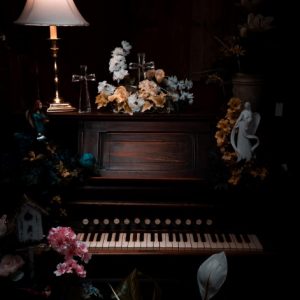
Haunted Houses | Summary and Analysis
“Haunted Houses” is a poem written by Henry Wordsworth Longfellow. In the poem all the men who lived in their…
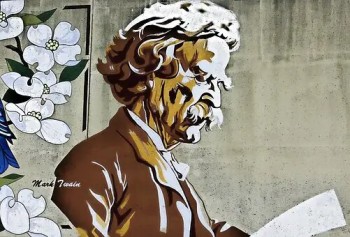
Advice to Youth by Mark Twain Summary
Advice to Youth by Mark Twain is a satirical speech that exposes the fallacies of elders giving advice to the young generation despite being…
Litmarked : Bookmarked by Students.

tomorrow’s daughters poetic devices

Tomorrow’s Daughter’s | Summary and Analysis
“Tomorrow’s Daughters” is a beautiful feminist poem by the famous South African author and performance poet, Lebogang Mashile. She is…
Adblock Detected

Tomorrow's Daughters | Analysis (Lines 1 - 7) The poet talks of her desire to write a poem about " pretty black girls". Immediately, the themes of gender and race is introduced in the poem. The girls are not complacent about the status quo - both of gender and race. They "don't relax and lie their dreams away".
Emily Dickinson, I am climbing through. To your wooden shed of isolation. Where the robin's song. Robbed you of your sanity. I revere people to my own detriment. Perhaps you did too. But when I enter your hallowed hearth. Please don't turn me away. I want to show pretty black girls.
Lebo Mashile. July 3, 2023. "Tomorrow's Daughters" by Lebo Mashile is a powerful and meaningful piece that highlights the importance of representation and empowerment for black women. Through her lyrical prowess, Mashile addresses the struggles faced by black girls and women, while also celebrating their strength and potential.
23. Rating. Showing Page: 1/23. The poem challenges society’s expectations in future black girls. The speaker needs the inspiration of a black poet in order to write poetry about ...
Video includes a reading of the poem as well as full analysis. It was one of the poems selected by our school English department this year for the Grade 11s....
SUBJECT: English Grade: 11 Topic: Poetry-Tomorrow's Daughter by Lebogang Mashile Theme: Gender and Race Term: 3 Week: 5 Duration: 1 period/50 minutes Prior knowledge: Link with this lesson: Language concepts. Highlight the use of alliteration, figures of speech, etc in the analysis of the poem.
Tomorrow's Daughter's | Summary and Analysis. "Tomorrow's Daughters" is a beautiful feminist poem by the famous South African author and performance poet, Lebogang Mashile.
Tomorrow's Daughters poem analysis. Lit Guides. Litbug Staff August 24, 2022. 0 4,417 . Tomorrow's Daughter's | Summary and Analysis "Tomorrow's Daughters" is a beautiful feminist poem by the famous South African author and performance poet, Lebogang Mashile. She is…
To your wooden shed of isolation. Where the robin's song. Robbed you of your sanity. I revere people to my own detriment. Perhaps you did too. But when I enter your hallowed hearth. Please don't turn me away. I want to show pretty black girls. How to look at their hearts.
Lebo Mashile's "Tomorrow's Daughters" was described by three of the five educators at the former Model C school as a poem that formed part of the curriculum and excited learners. Unlike Shakespearean sonnets, "the language, the concepts, the ideas, the themes" of this poem are accessible to learners.
Terms in this set (22) Themes. Feminism, women empowerment, race, gender and the power of change. "Tomorrow's daughters". embodies a message of change and bevomes the voice of the present engagong with the experiences of the past, in order to encourage and empower the future. Tone.
Study with Quizlet and memorize flashcards containing terms like 1. Name one of the "disciplined silent screams" that the speaker respects., 2. quote three separate words or phrases from the poem that give an indication of Emily Dickinson's character and life., 3. Explain how the phrase "disciplined silent screamers" affects your understanding of women. and more.
Line analysation 11. metaphor relates to the consequences of fighting for change/being a radical, principled voice. how it can isolate one from society. Line analysation 12. the robin is a common symbol in Dickinson's work, it represents hope and change. Line analysation 13.
The poem is rich with metaphor, symbolism, and figurative language, and it captures themes of womanhood and identity. Explanation: The topic of the question appears to involve analyzing the poem 'Tomorrow's Daughter' by Lebogang Mashile, within the scope of an English subject and particularly literary analysis. For this type of question, it ...
This is a significant point, as movement is prerequisite to change, an important theme with which the poem ends. Metaphors such as in "hair thin slices of movement", "voices that curl the straight edges of history" add both power and beauty to the opening portion of the poem. Tomorrow's Daughters | Analysis (Lines 8 -21)
These are the answers to the poem "Tomorrow's daughters" by Lebogang Mashile.
Tomorrow's Daughters by Lebogang Mashile 161 The ride by Joyce Chigiya 164 Calvinia, 1976 by Jacques Rousseau 166 To My Father, Who Died by Dawn Garisch 169 Give by Gabeba Baderoon 172 ASSESSMENT QUESTIONS 175 REFERENCE PAGE 180 BBSG_Poems_from_all_over_[5].indd 8 2016/05/16 3:47 PM
Find the perfect quote and understand it. Line-by-line poetry analysis. Break down every poem we cover. Shakespeare translations. Line-by-line translations of every play. Teacher Editions. Close reading made easy for students. PDF Downloads. Download and print any of our guides.
Australian poet, writer, and environmentalist Judith Wright's poem Eve to Her Daughters carries the central message that an age of scientific revolution often leads man astray from his Faith; he perceives himself as a god.Though Wright does not address women well until the eighth stanza, it is evident that the poem is an open call to women to not be the submissive gender and bring back faith ...
Your response should take the form of a well-constructed essay of 200-250 words in length (1 page) [10 MARKS] ... The poem 'Tomorrow's Daughters' reflects feminist poetry by affirming the strength and abilities of women, especially black women, who suffered under the oppression of apartheid and patriarchy. Through careful analysis of diction ...

IMAGES
VIDEO
COMMENTS
Atlantide was re-launched in 1999 as the world's most elegantly detailed expedition yacht with a proper sailplan on two spars, including a square sail for downwind and capability of 7 knots under sail alone! With her Vosper stabilizers and a range of 3,250 miles, she has regularly sailed trans-Atlantic and voyaged from the Norwegian Fjords to ...
Atlantide is a motor yacht with an overall length of m. The yacht's builder is Philip & Sons from United Kingdom, who launched Atlantide in 1930. The superyacht has a beam of m, a draught of m and a volume of . GT.. Atlantide features exterior design by A. Mylne & Co and interior design by Ken Freivokh Design. Up to 6 guests can be accommodated on board the superyacht, Atlantide, and she also ...
ATLANTIDE, a 37.28 m Motor Yacht built in the United Kingdom and delivered in 1930, is the flagship of Philip. Her top speed is 12.0 kn and she boasts a maximum range of 3250.0 nm when navigating at cruising speed, with power coming from two Gardner diesel engines. She can accommodate up to 6 guests in 3 staterooms, with 6 crew members waiting ...
Atlantide was launched in 1930 as Caleta, for Sir William Burton who was the helmsman aboard Shamrock IV, the J-Class challenger to the America's Cup.She was designed by the gifted naval architect Alfred Mylne, designer of the Royal Yacht, Britannia and built by Philip and Sons of Dartmouth, UK.Under Burton's ownership, Atlantide was tender to his William Fife designed 12-Meter Iyruna ...
Performance and Capabilities. Atlantide has a top speed of 12 knots. She is powered by a twin screw propulsion system. Atlantide is a custom motor yacht launched in 1930 by Philip & Sons. Design. Atlantide measures 37.28 metres in length, with a max draft of 2.71 metres and a beam of 5.46 metres. She has a gross tonnage of 137 tonnes.
By Andrei Dragos. January 15, 2021. 1674. The team of Royal Huisman and Huisfit is honoured to merit the continued trust of Dr. Jim Clark, who commissioned the shipyard to carry out the very special restoration of his most recent acquisition, the 1930's yacht Atlantide. This 37m / 122ft classic motorsailer was shipped from Newport, USA, to ...
Updated October 11, 2022 in Brokerage & New Build. Northrop & Johnson is delighted to announce the in-house sale of the 122-foot (37.19m) ATLANTIDE by Yacht Broker Hank Halsted, representing the buyer and the seller. Built in 1930, ATLANTIDE has been the pinnacle of iconic classic yachts at every turn of her 90-year history.
37m Atlantide completes two-year rebuild at Huisfit. Huisfit, the refit arm of Dutch shipyard Royal Huisman, has announced that the 37.3-metre Atlantide is ready to be relaunched following a major two-year rebuild. The classic 1930s motorsailer arrived at the Vollenhove yard for a cosmetic refresh in January 2021 and has been undergoing work ...
About Atlantide. Atlantide is a 37.28 m / 122′4″ luxury sailing yacht. She was built by Philip & Sons in 1930. With a beam of 5.46 m and a draft of 2.71 m, she has a steel hull and aluminium, teak superstructure. This adds up to a gross tonnage of 137 tons. She is powered by Gardner engines of 230 hp each giving her a maximum speed of 12 ...
Download the full charter brochure for luxury Motor Yacht "ATLANTIDE" to explore her beautiful interiors, guest accommodation and full range of amenities as well as outdoor living spaces. This comprehensive overview provides the best way to get a feel for the charter experience on offer and gives detailed and accurate specifications so that you can match them up to your own requirements.
Built in 1930, Atlantide (as she is now known) is now in her 90s - a venerable old lady, sprightlier than most nonagenarians after judicious refits. She is a beautiful boat with an illustrious past. Designed by Alfred Mylne, Atlantide served as a tender for a J Class America's Cup challenger. Then, in 1940, she was one of the "Little Ships" that evacuated more than 330,000 Allied ...
A Summary of Motor Yacht ATLANTIDE. The well proportioned superyacht ATLANTIDE is a motor yacht. This 37 m (122 ft) luxury yacht was developed at Philip & Son in 1930. ATLANTIDE was formerly called Caleta; Ariane; Corisande. Superyacht ATLANTIDE is a beautiful yacht that is able to accommodate up to 6 people on board and has approximately 6 ...
Northrop & Johnson has sold the 37.19-metre sailing yacht Atlantide in-house with a last asking price of $5,495,000. Delivered to her original owner in 1930 under the name Celeta, the iconic classic yacht was designed by Alfred Mylne and built by Phillip & Sons for Sir William Burton. Burton enjoyed the yacht for a decade until she was recruited to Operation Dynamo to help evacuate English and ...
The luxury motor yacht Atlantide is displayed on this page merely for informational purposes and she is not necessarily available for yacht charter or for sale, nor is she represented or marketed in anyway by Superyacht Network. This document is not contractual. The yacht particulars displayed in the results above are displayed in good faith ...
The yacht was created at Niarchos' own Hellenic Shipyard with design by Caesar Pinnau. Atlantis II is powered by two Pielstick diesel engines, with a top speed of 14 knots. The yacht, now owned by Philip Niarchos, son of Stavros Niarchos, has an estimated value of $100 million with annual running costs of approximately $10 million.
The yacht Atlante is estimated to be worth $40 million, with annual running costs of around $4 million. The price of a yacht can vary significantly based on factors such as size, age, level of luxury, materials, and technology used in its construction. This majestic yacht Atlante combines elegance, performance, and luxury, creating a truly ...
Atlantide Yacht for Sale is a 122 superyacht built by Philip & Son Ltd in 1999. Currently she is located in Camden, Maine United States and awaiting her new owners.
Atlantide is a visual feast, beginning with the inlaid marquetry of contrasting woods; quilted smoked maple, ebony, maple, and padauk, overlaid by abalone and mother of pearl roundels with trim and countertops of honey marble and other elegant contrasts that appear throughout the yacht. Under power, her top speed is 12 knots and she boasts a maximum cruising range of 3,250 nautical miles at 10 ...
DESIGN. To bring your wishes and dreams to reality you will have at your disposal a dynamic International team, featuring award winning Italian yacht exterior and interior designers and Dutch naval architects, working together in absolute harmony. The client inspires, the designers and engineers express, and the shipyard forms, all driven by ...
Round table 2021. "Electrostal" Metallurgical plant" JSC has a number of remarkable time-tested traditions. One of them is holding an annual meeting with customers and partners in an extеnded format in order to build development pathways together, resolve pressing tasks and better understand each other. Although the digital age ...
The Stunning Ritz Carlton EVRIMA Yacht. Gliding Across Tokyo's Sumida River: The Mesmerizing Zipper Boat. CROCUS Yacht: An 48 Meter Beauty by Admiral. PHI Yacht - Royal Huisma
Imagined by Flynt for the serious owner and strengthened by Dutch superyacht design studio Vripack's robust naval architecture, Flynt 956 means business. A deep-V planing hull tears across water making the boat efficient, rapid and easy to manoeuvre. It delivers top speed performance from the comfort of adjustable Recaro sport seats.... The Flynt 956 Nova is a 9.56 meters caddy boat with 1 ...
Built by a wide variety of yacht makers, there are currently 1,797 catamaran yachts for sale on YachtWorld, with 438 new vessels for sale, and 1,359 used and custom yachts listed. These vessels are all listed by professional yacht brokerages and new boat dealers, mainly in the following countries: United States, France, Croatia, Italy and Greece.